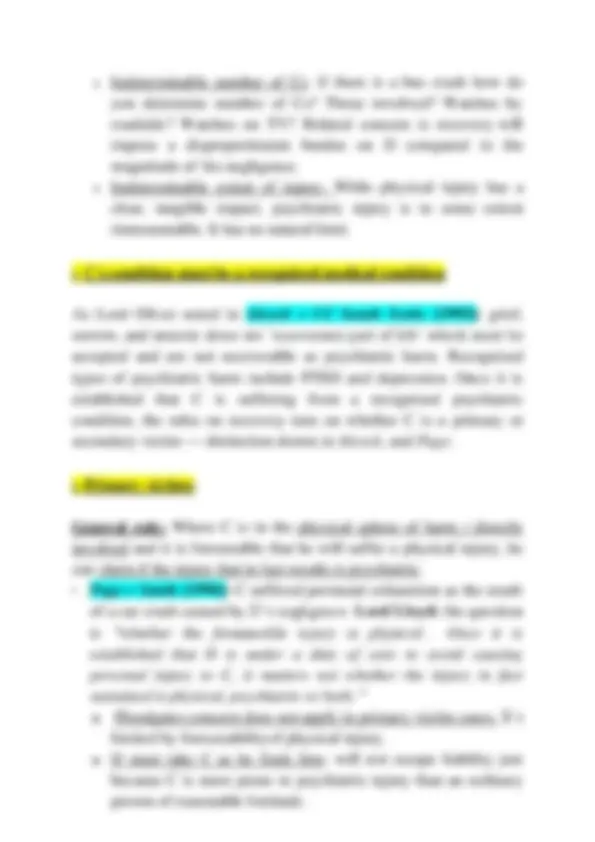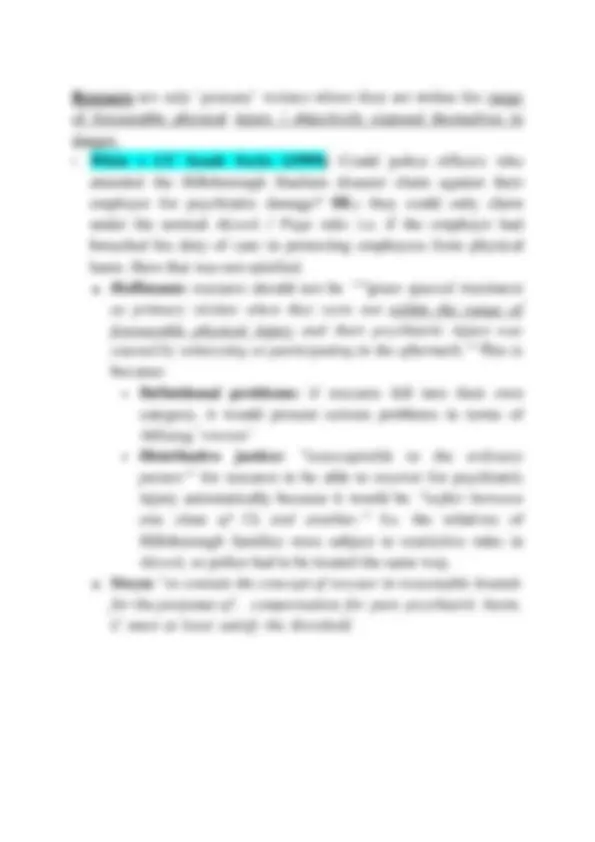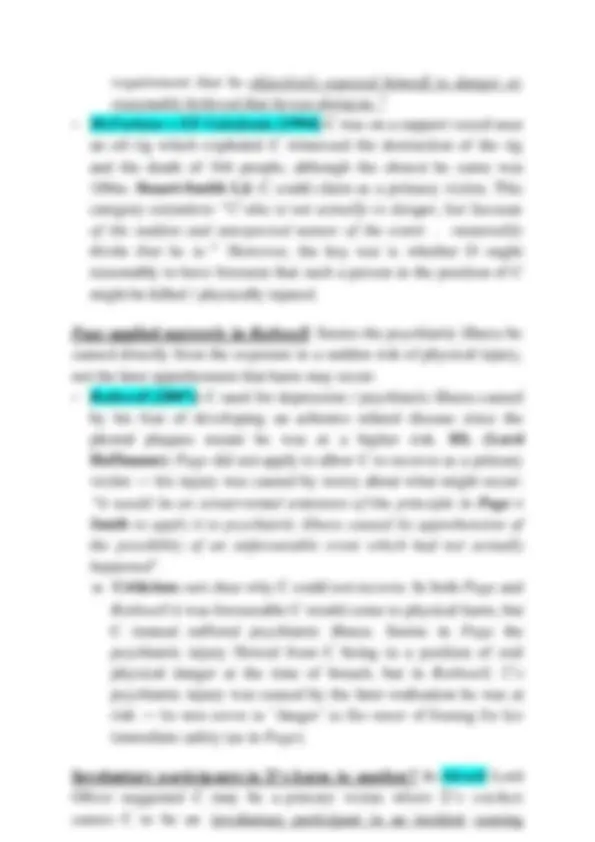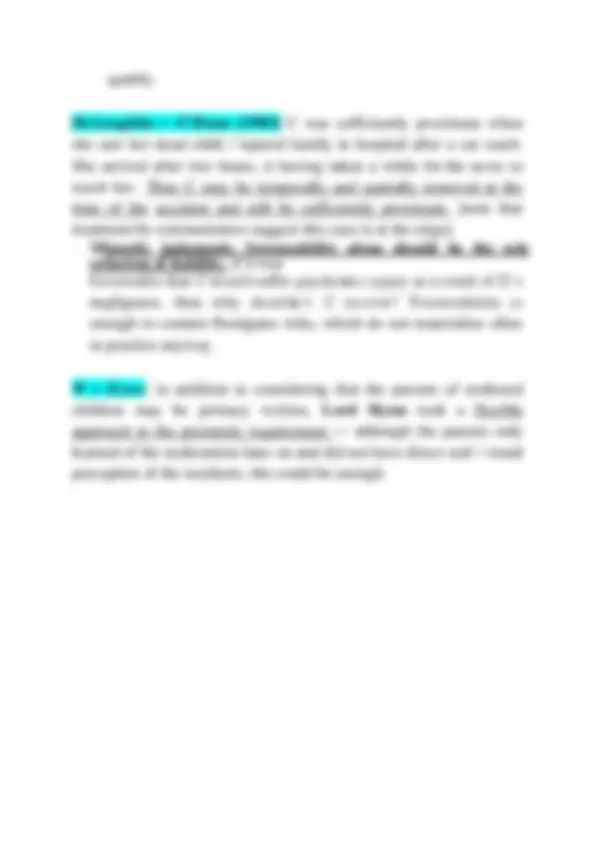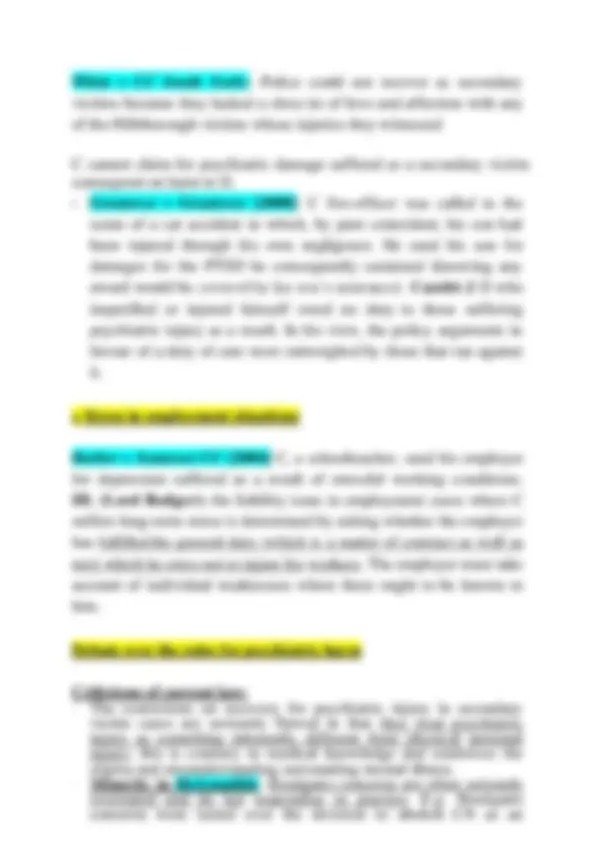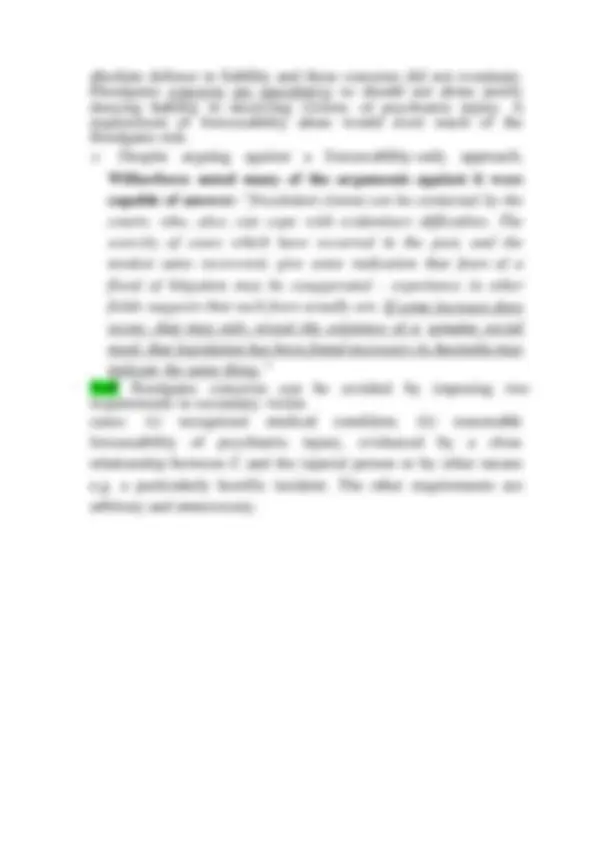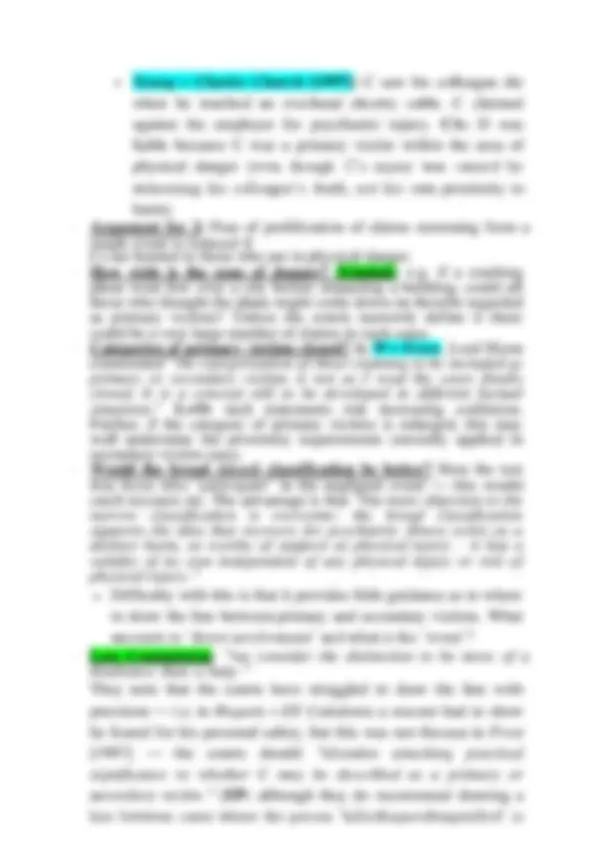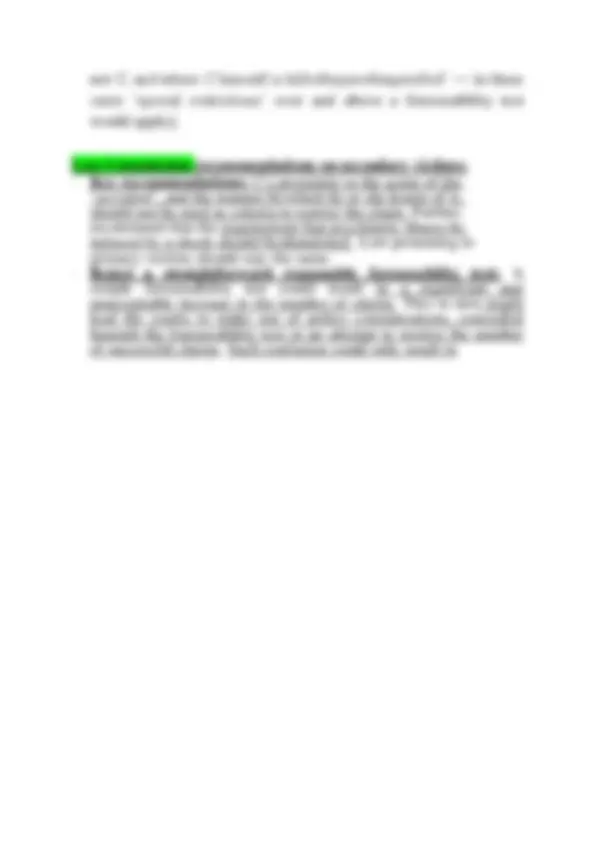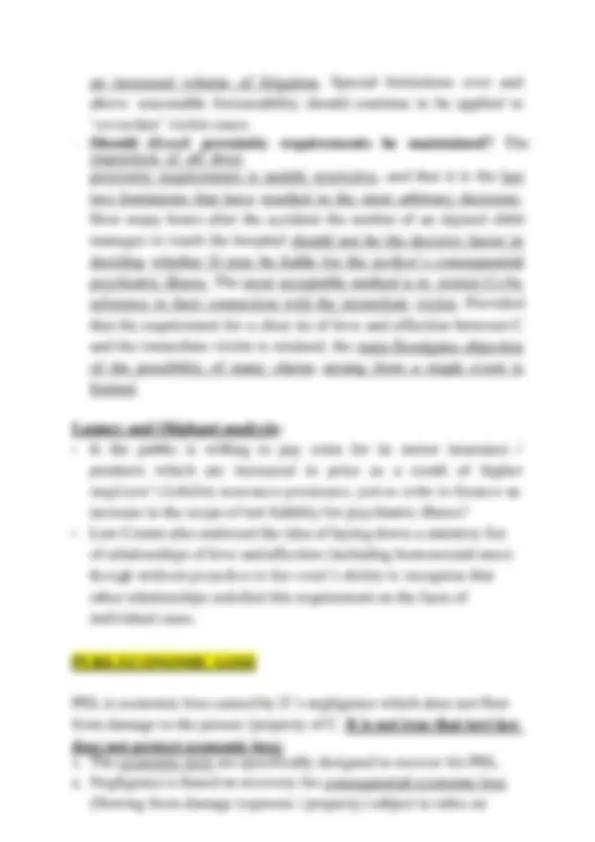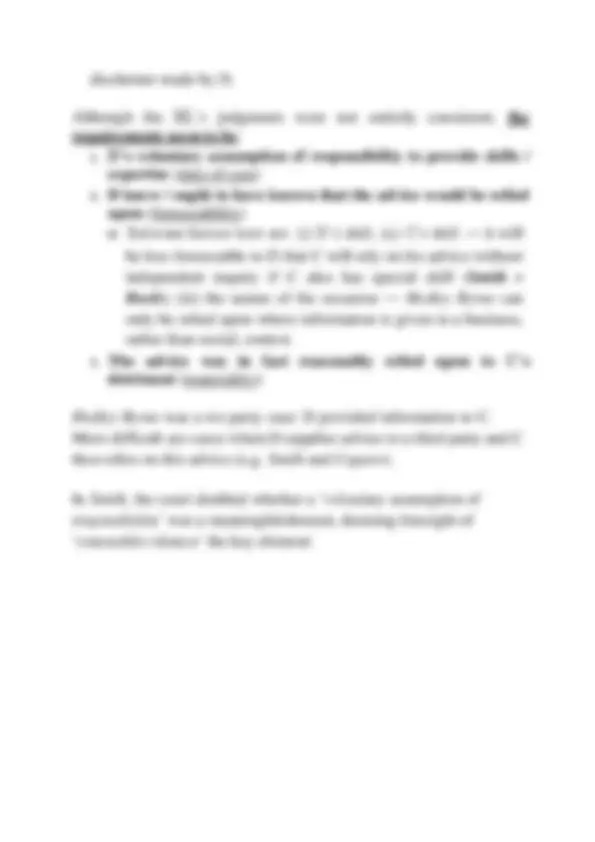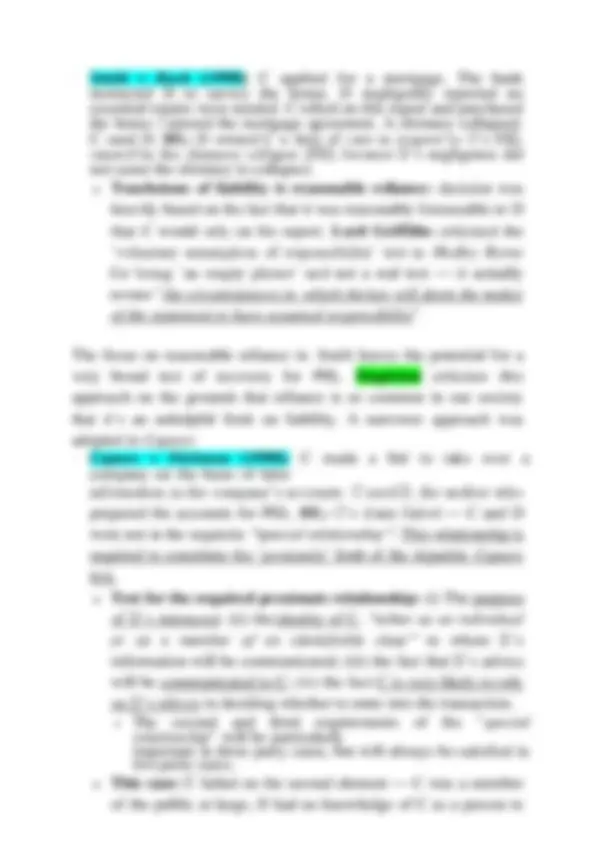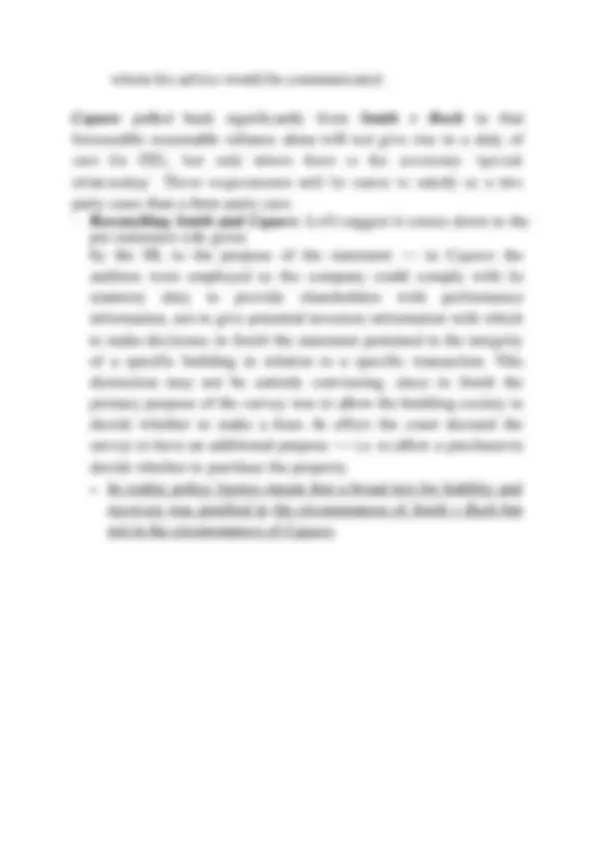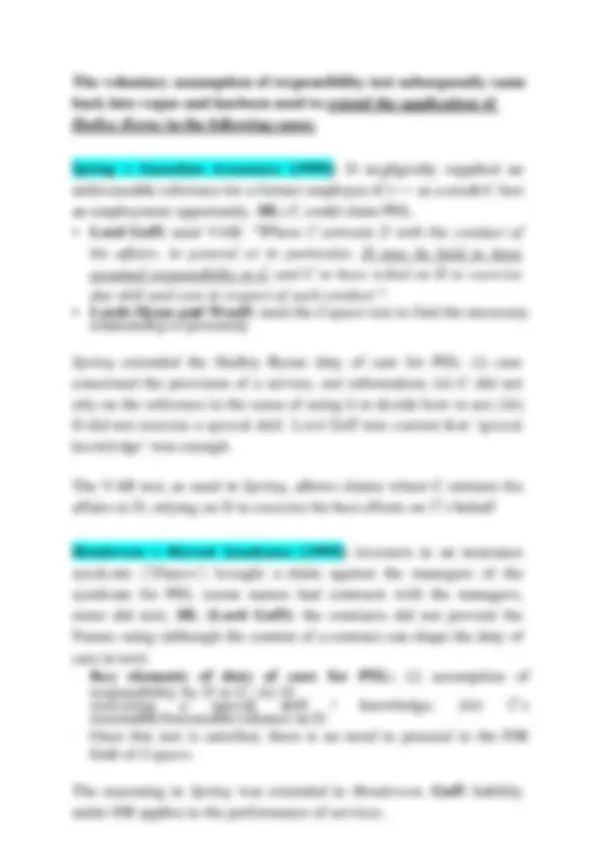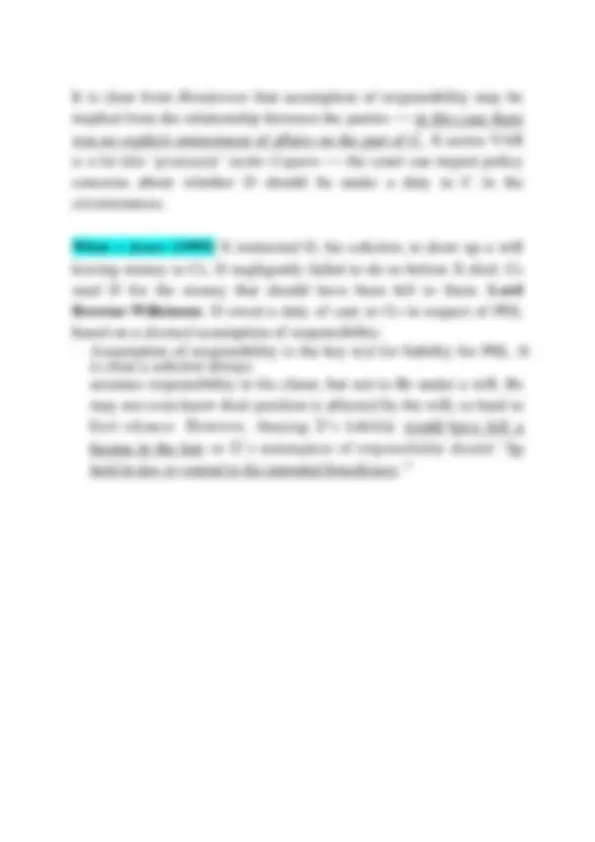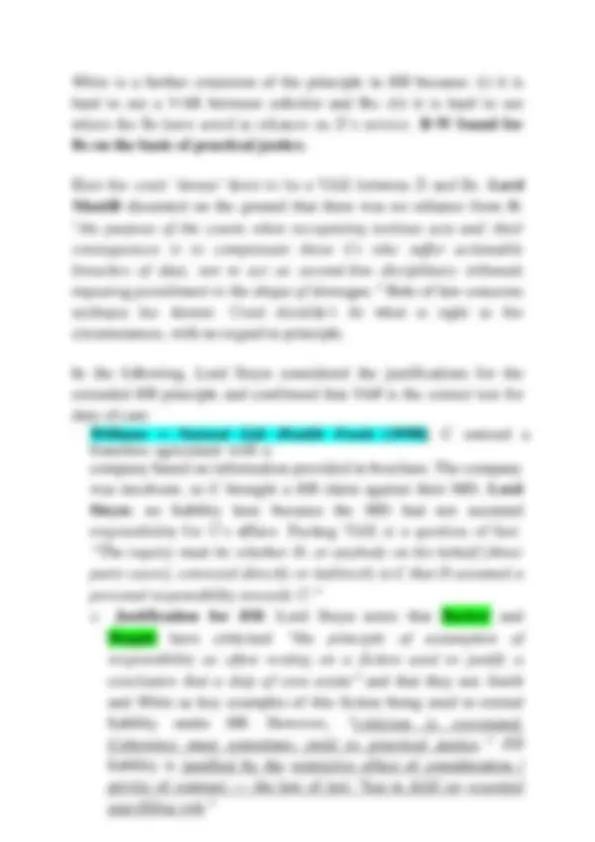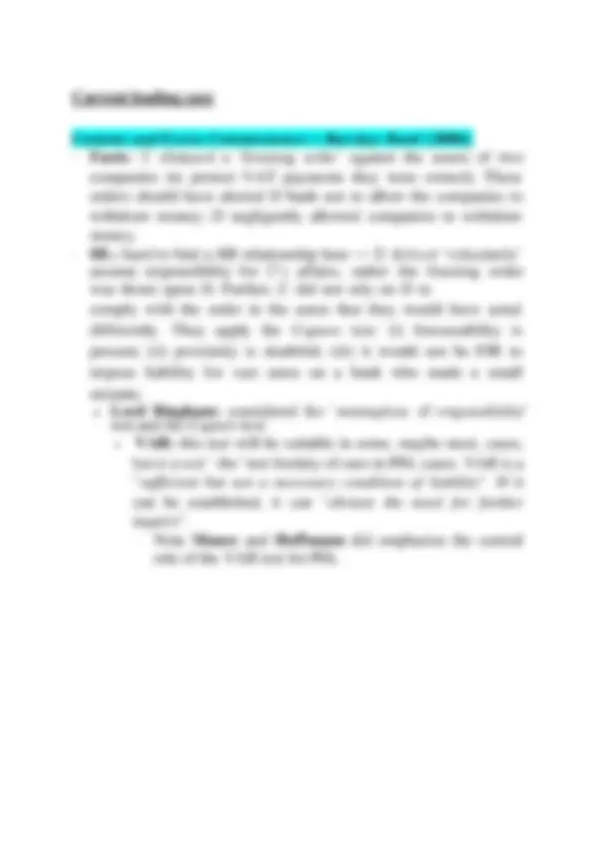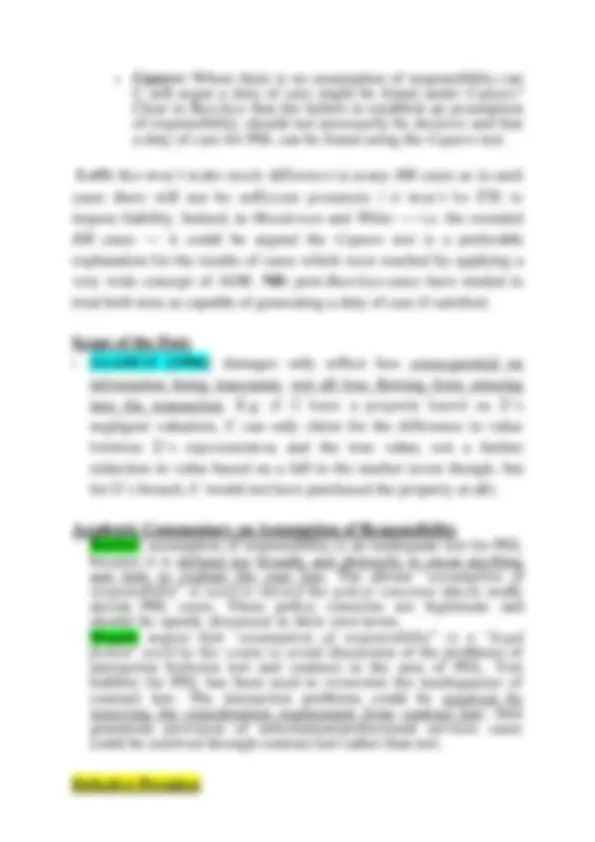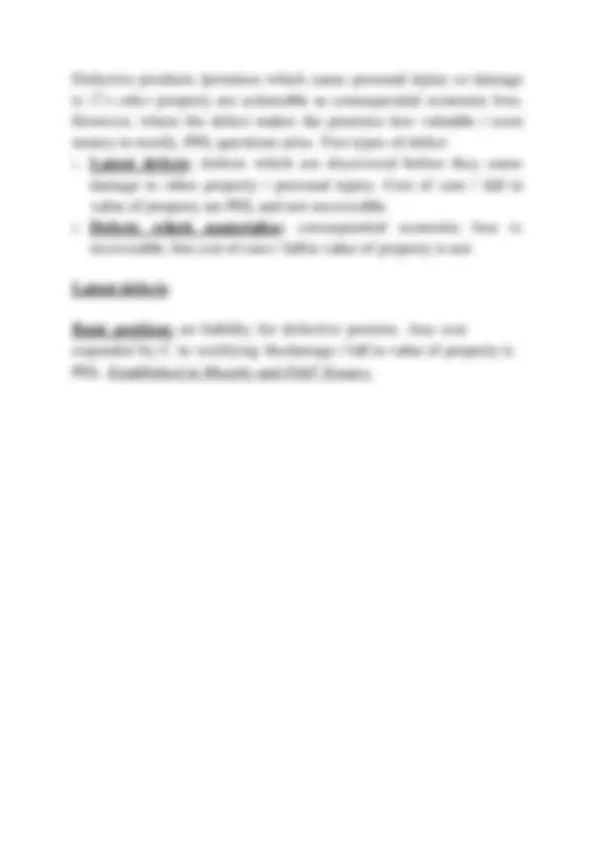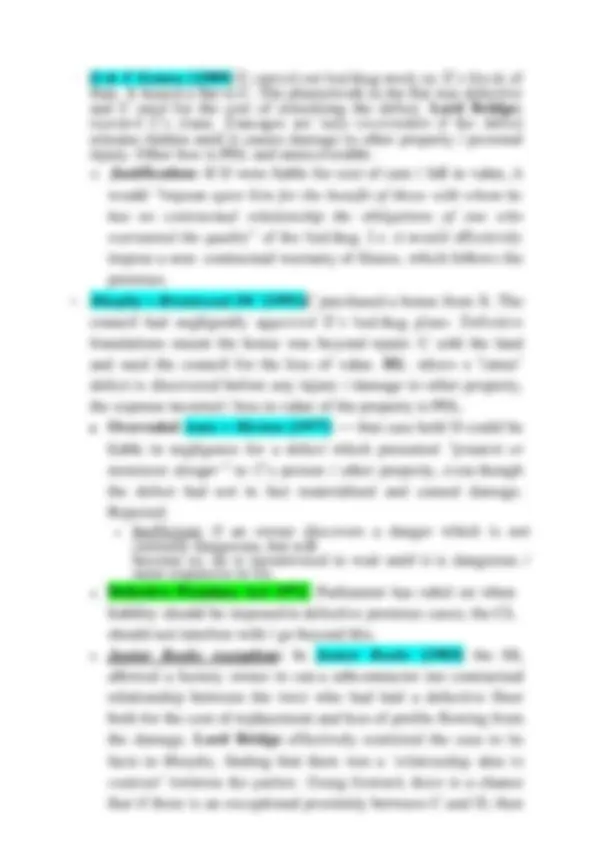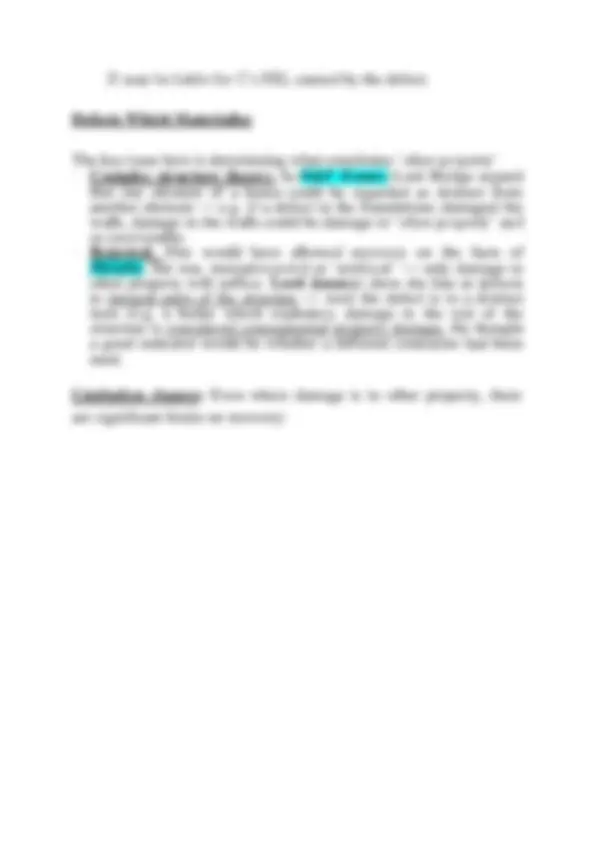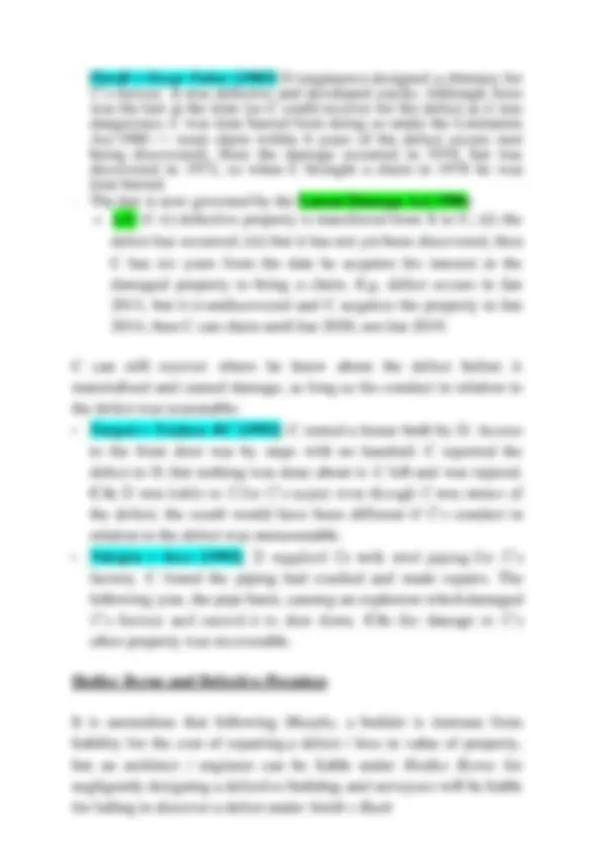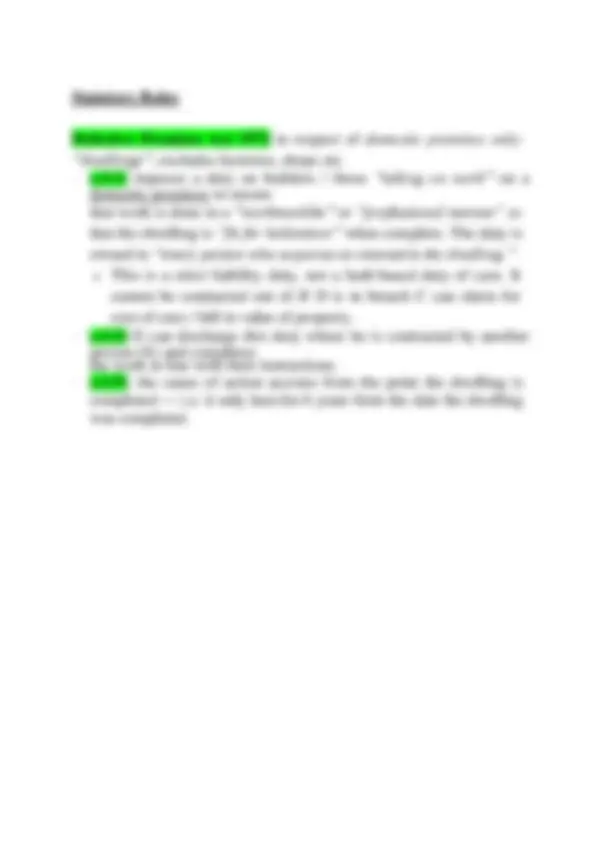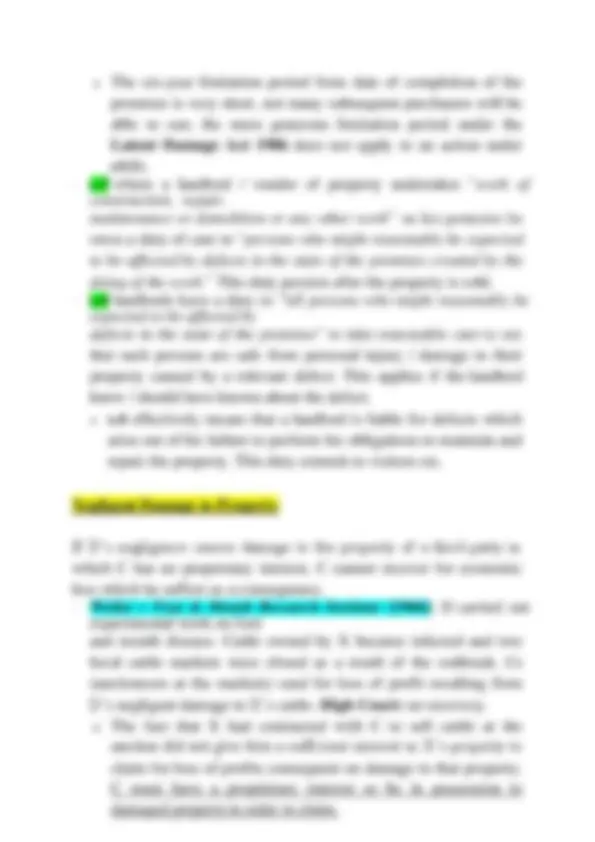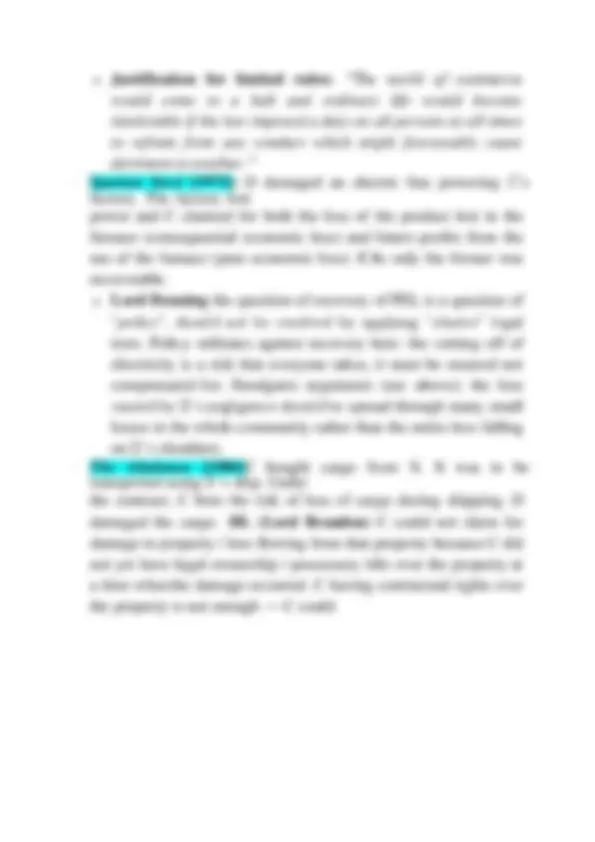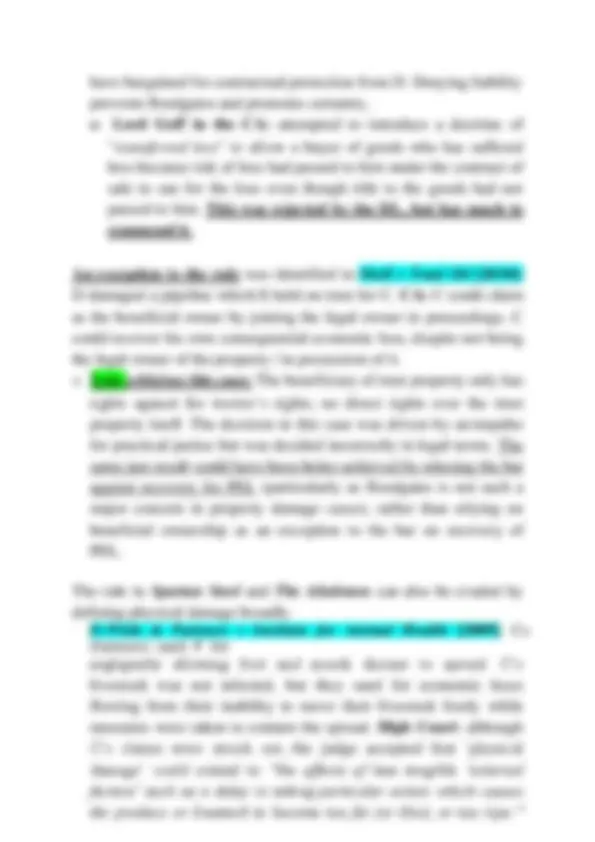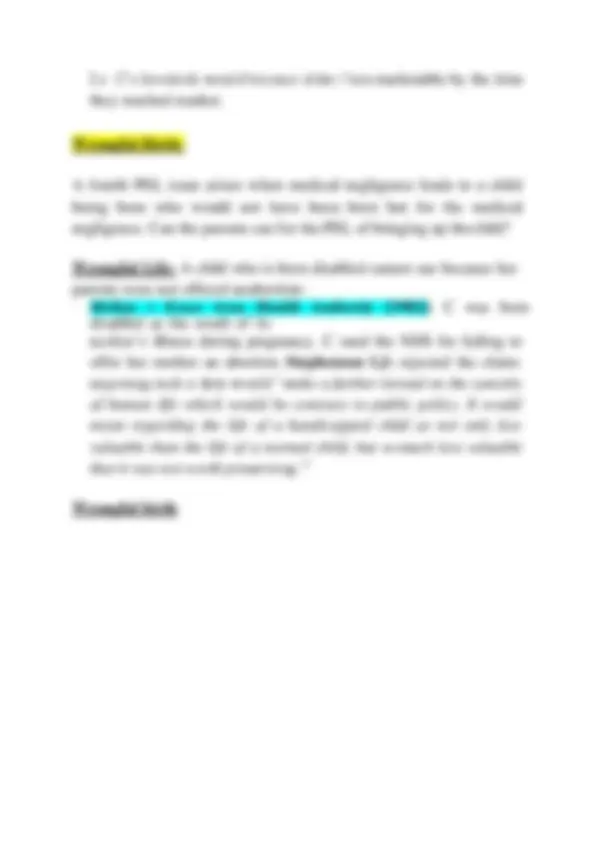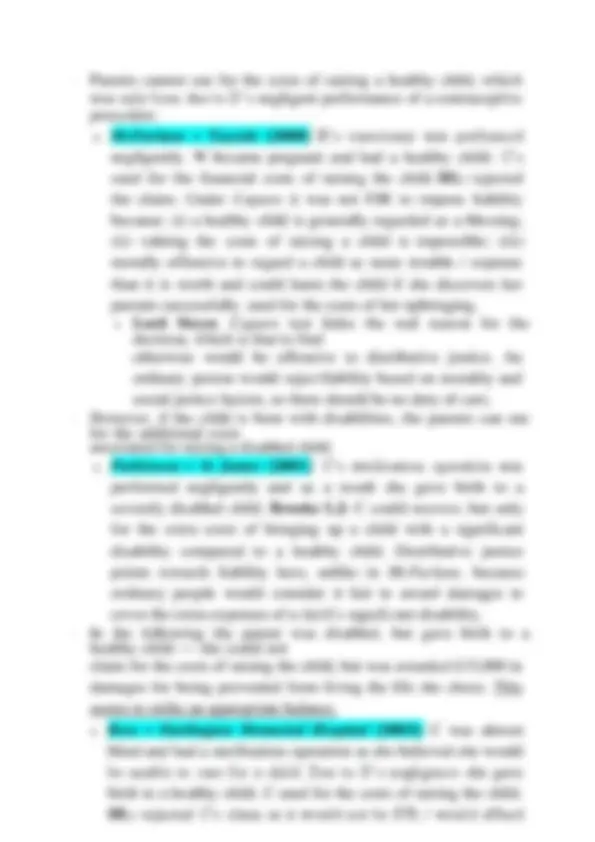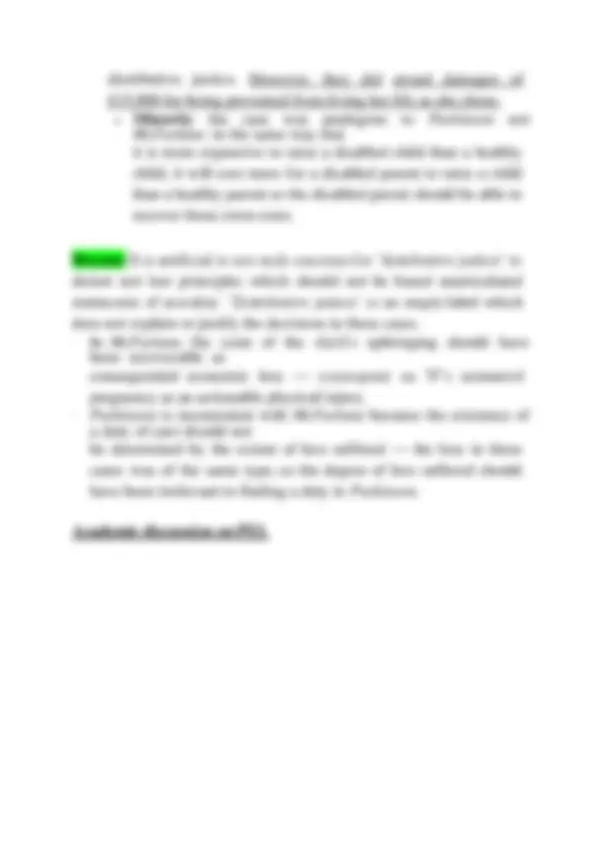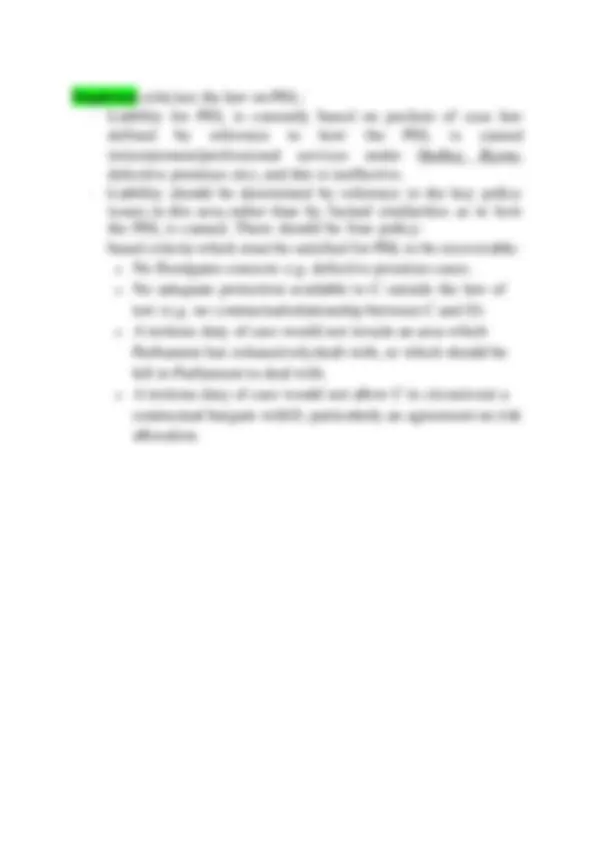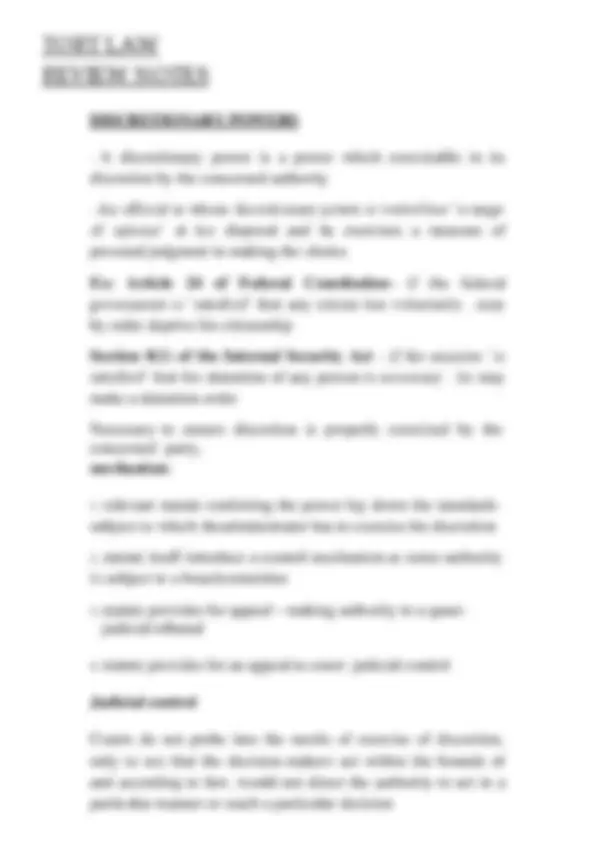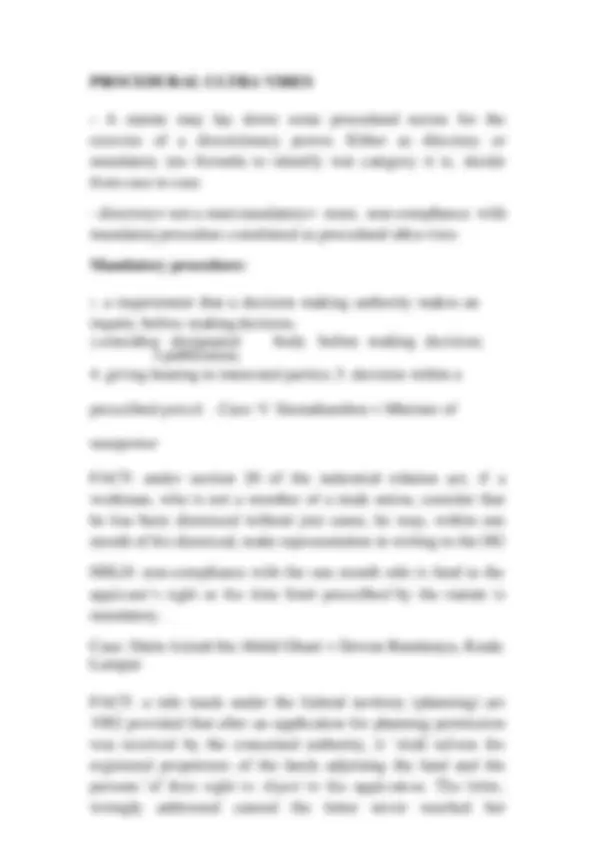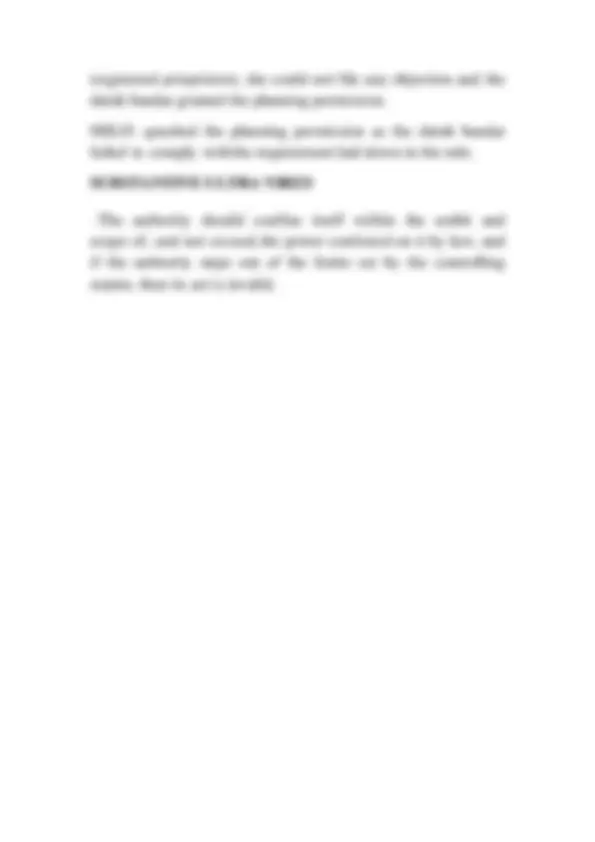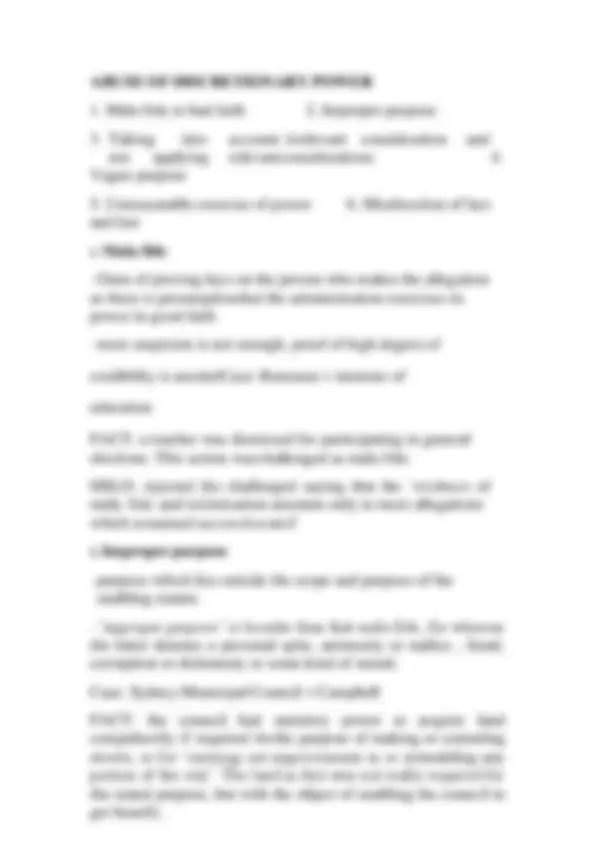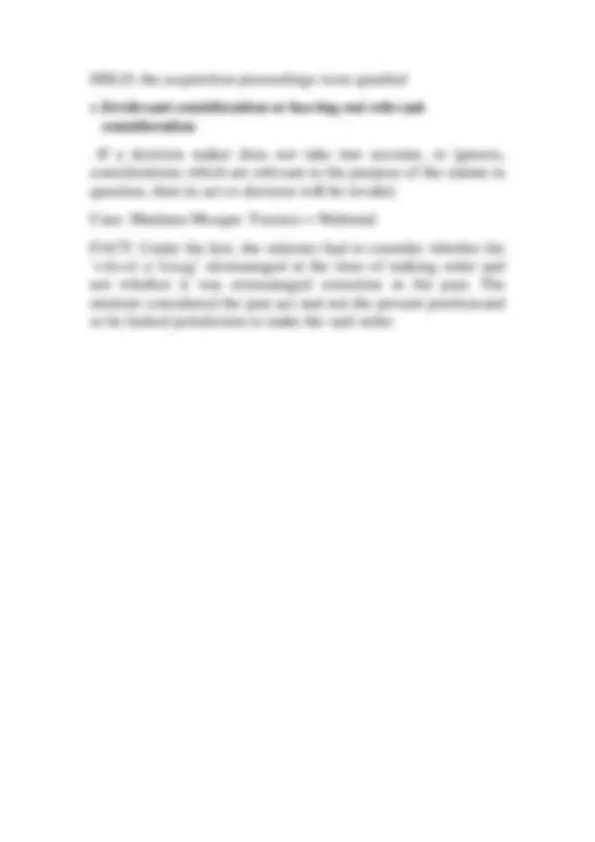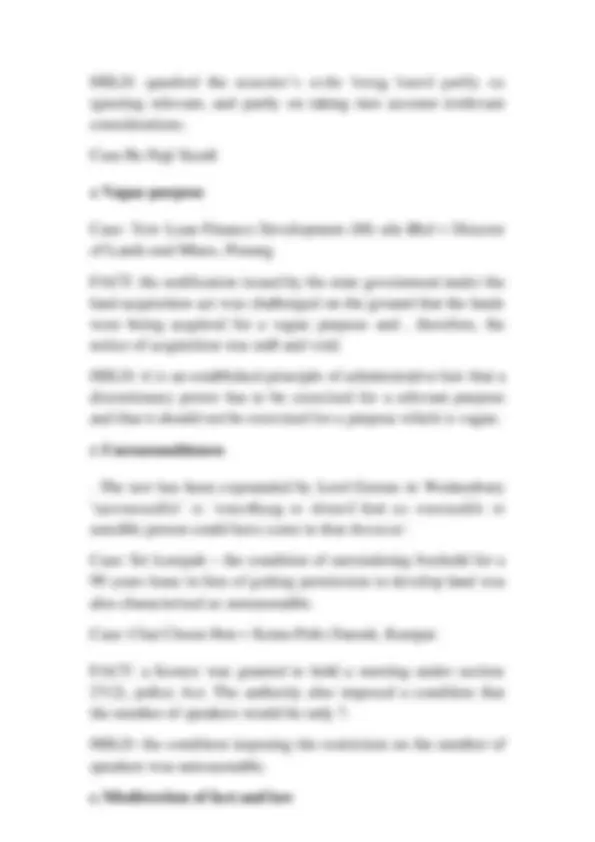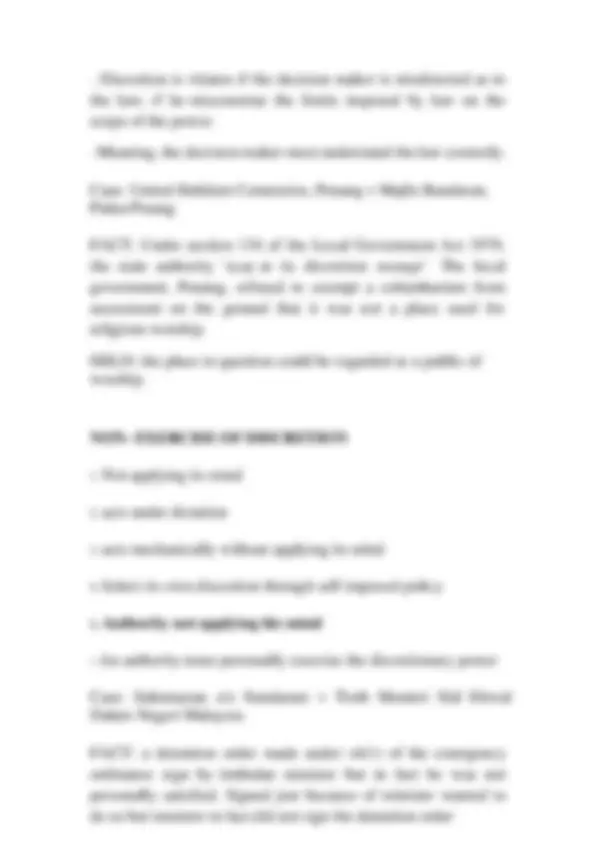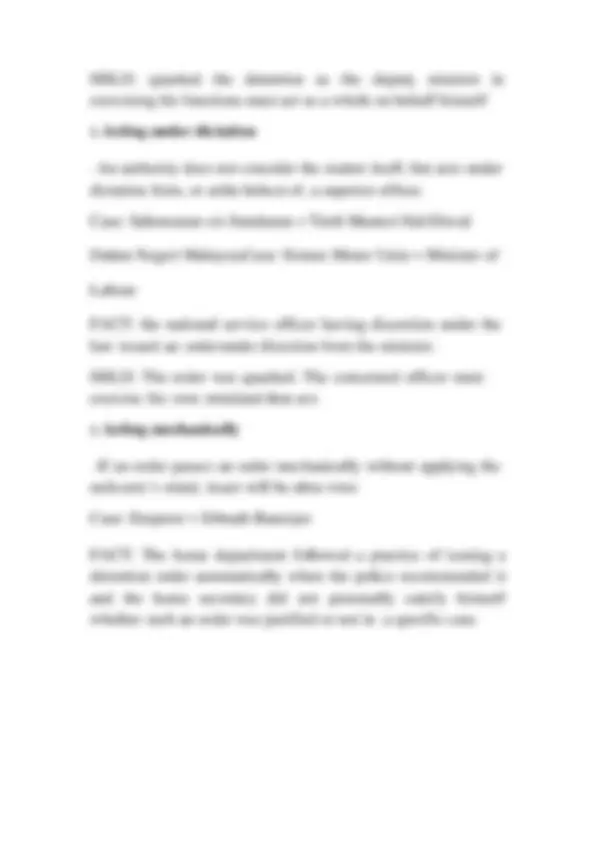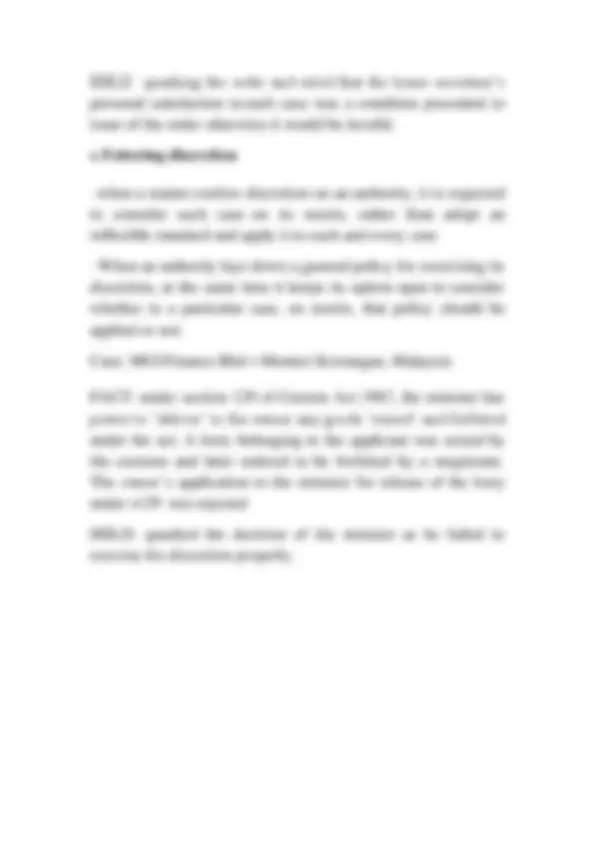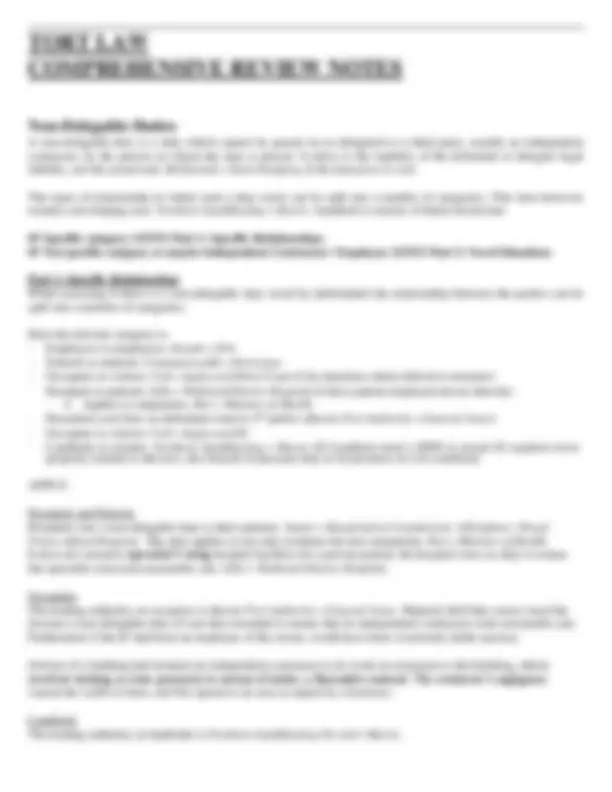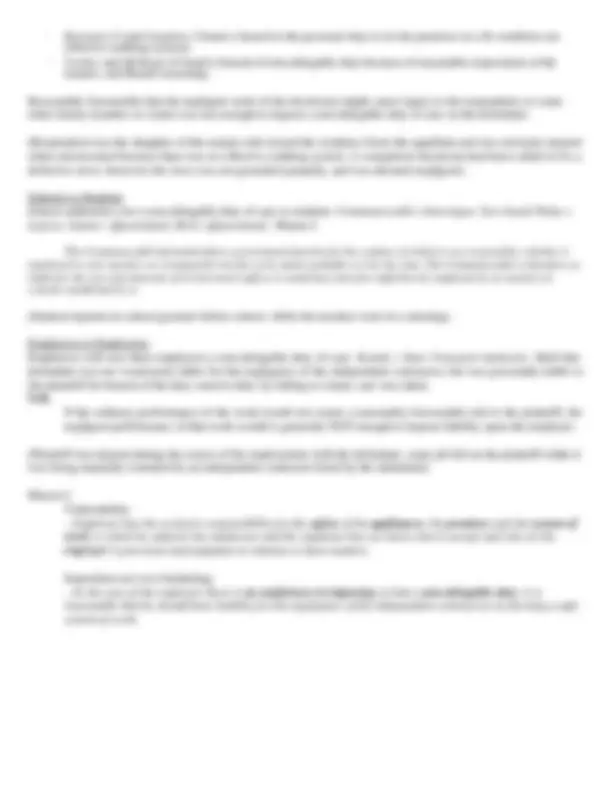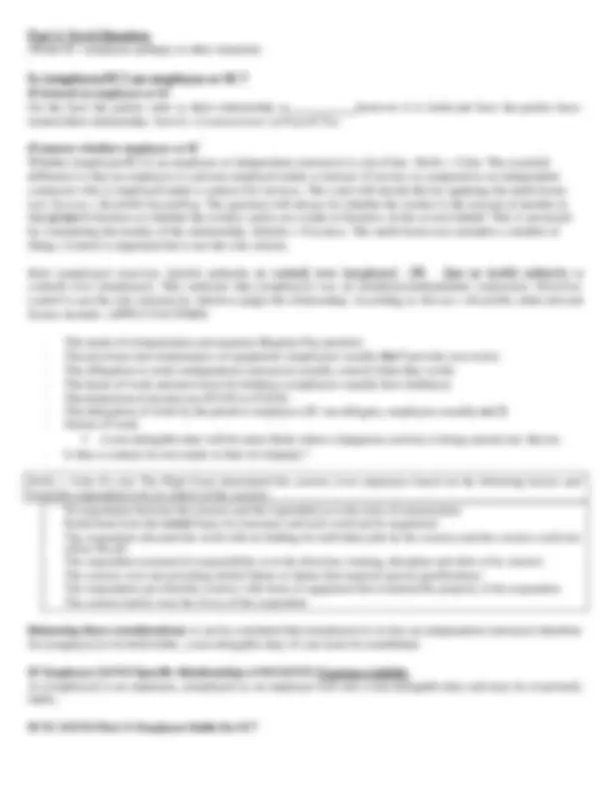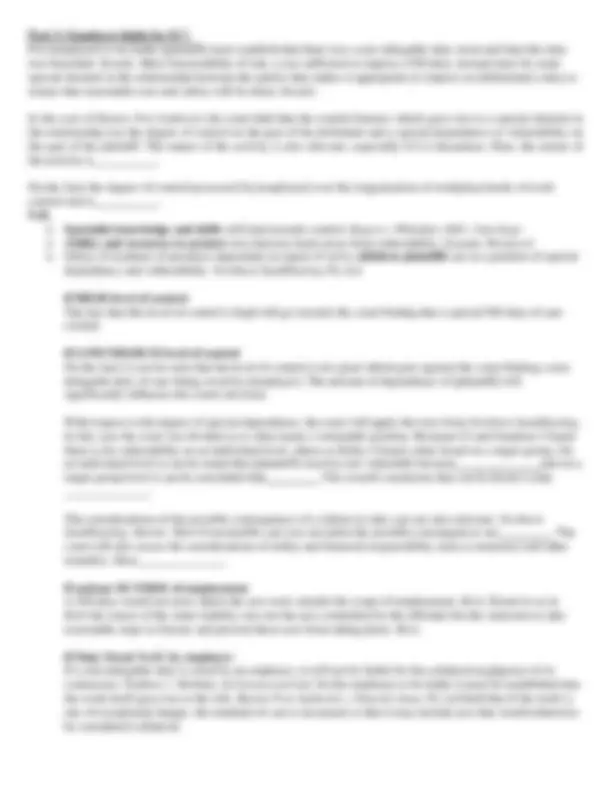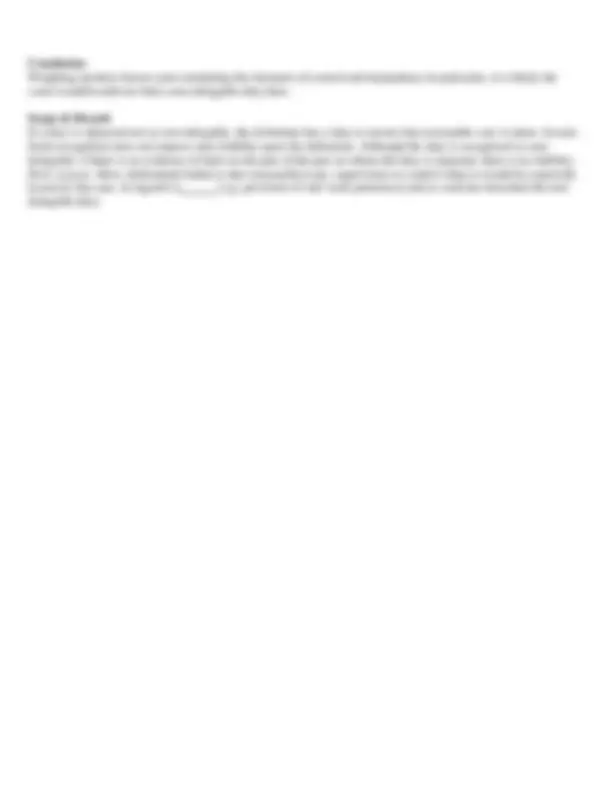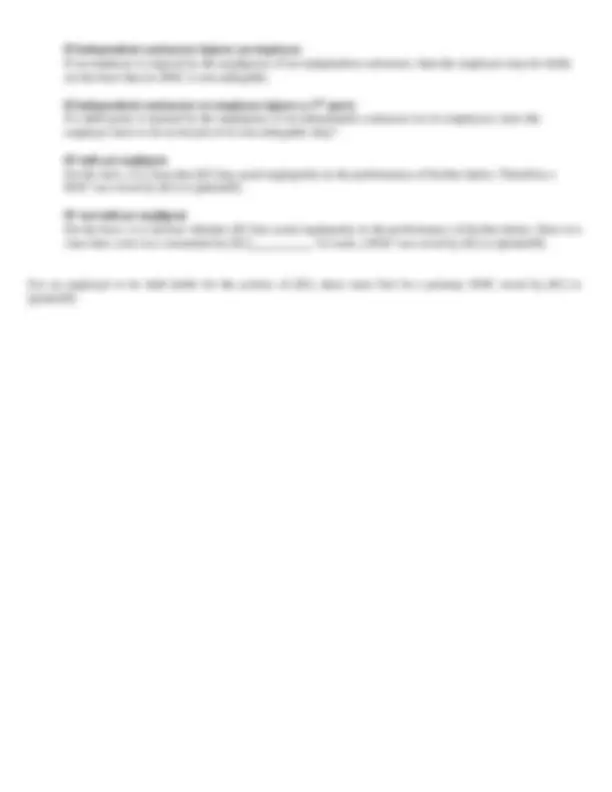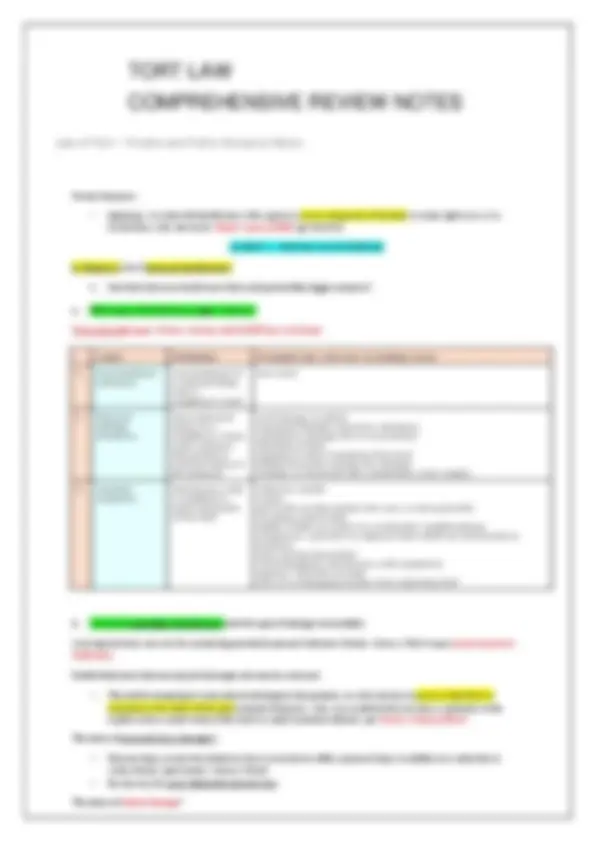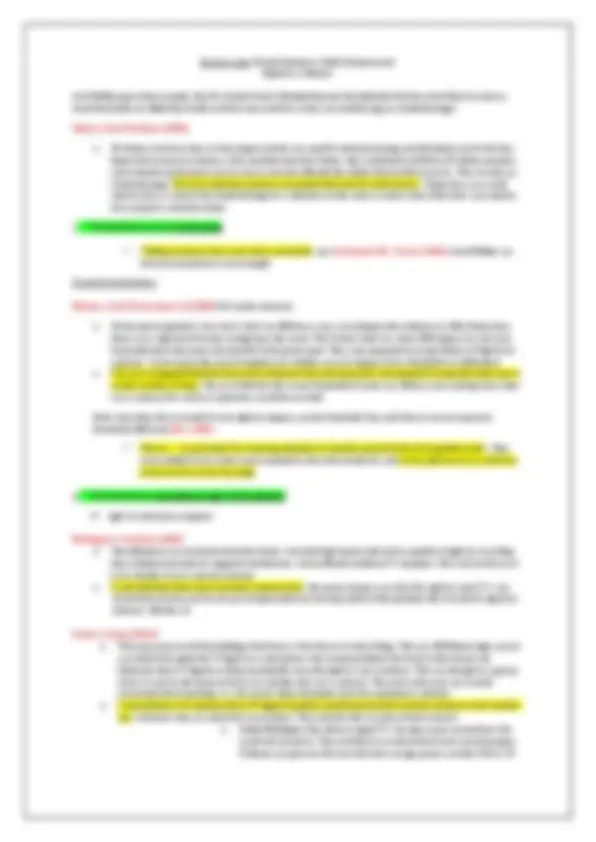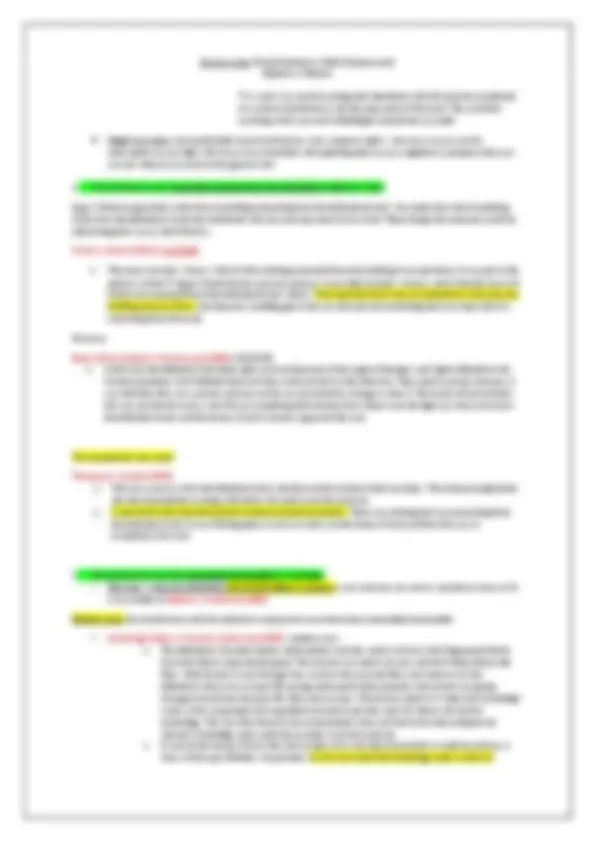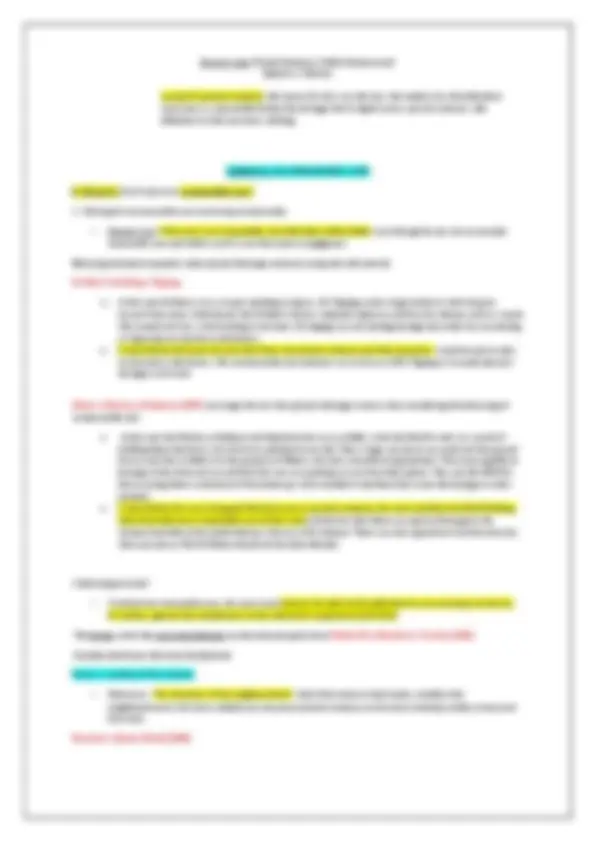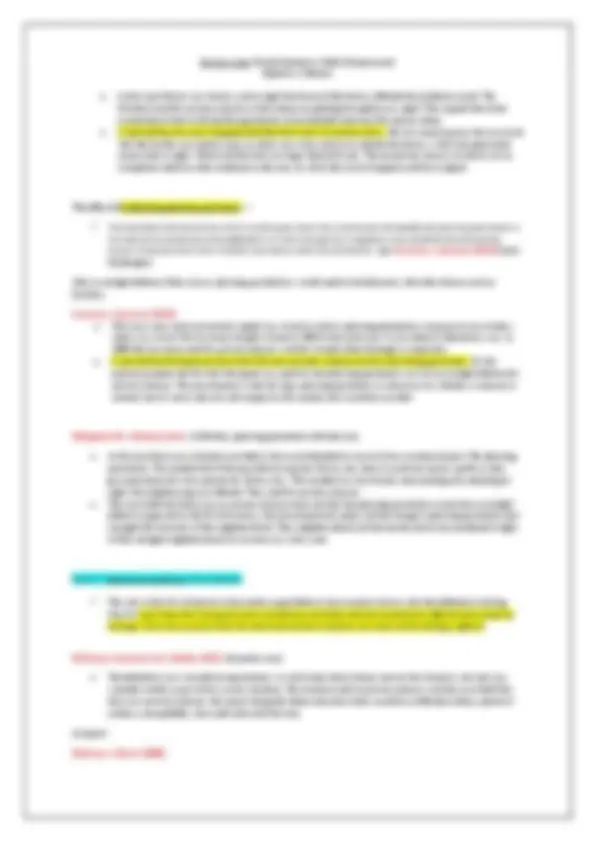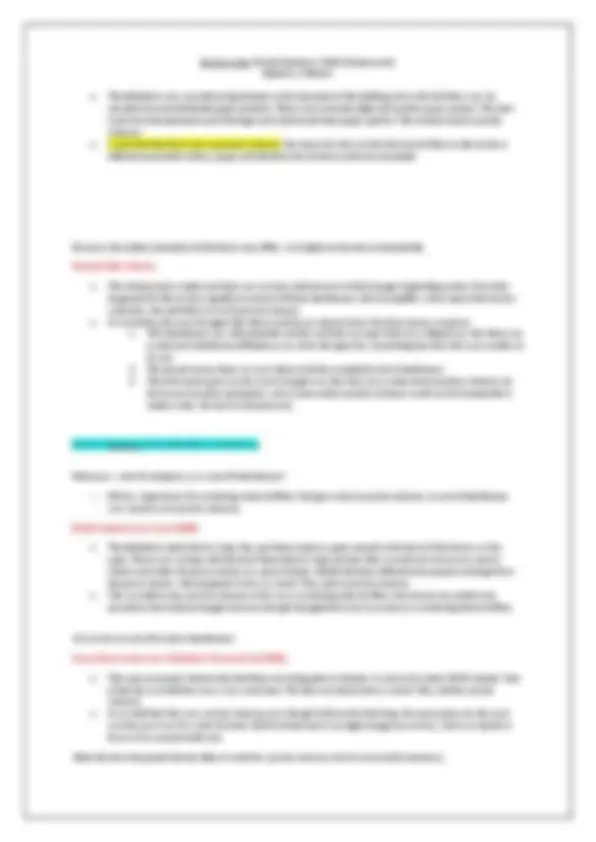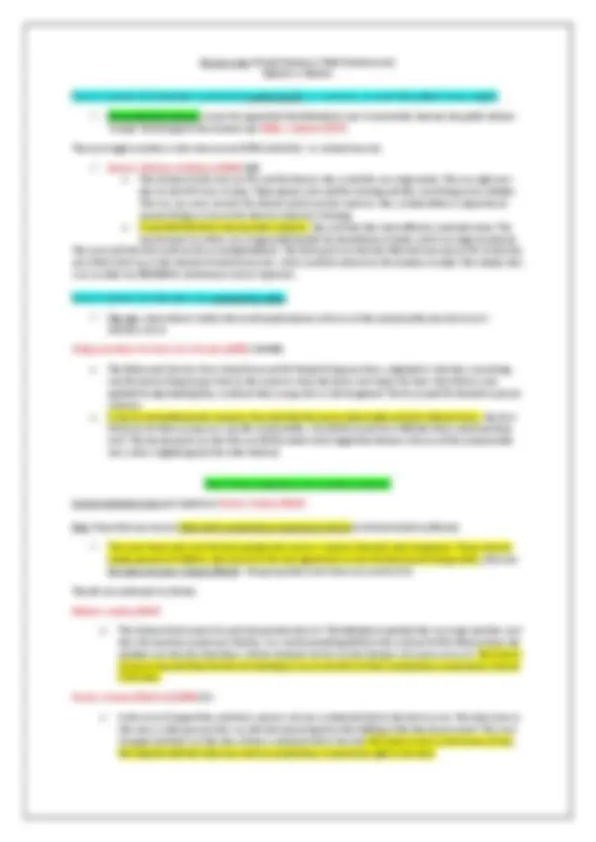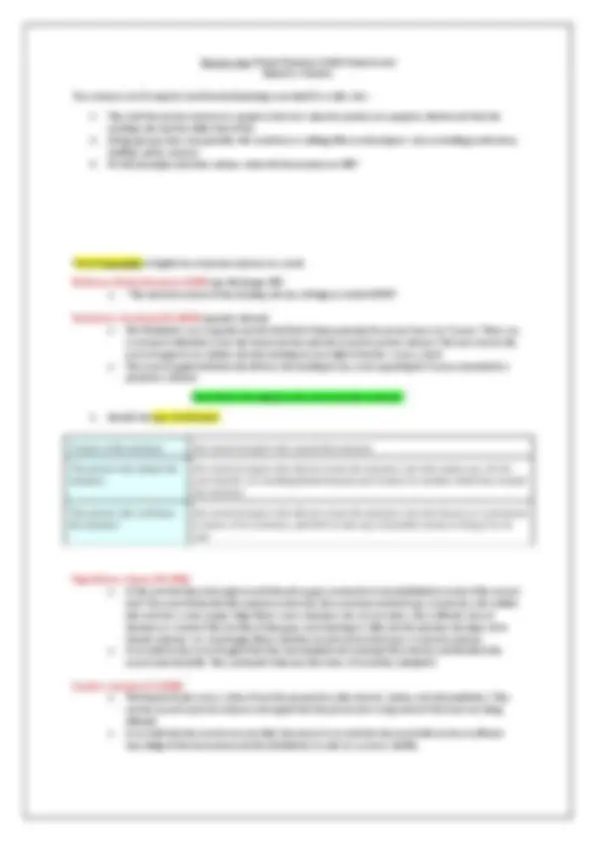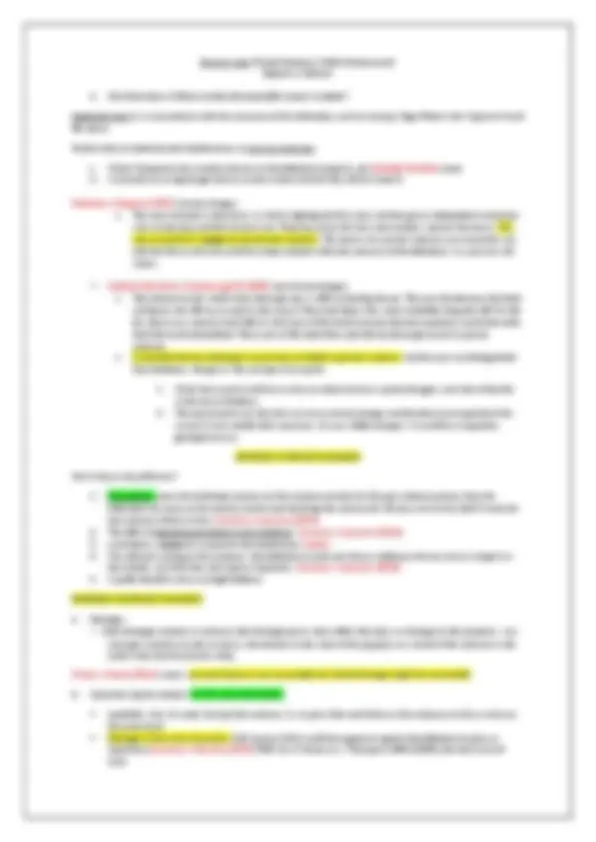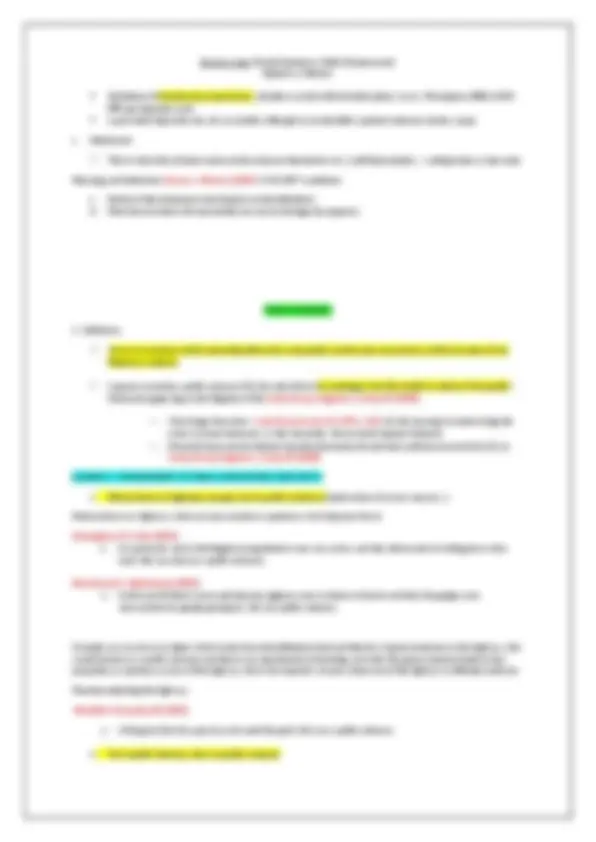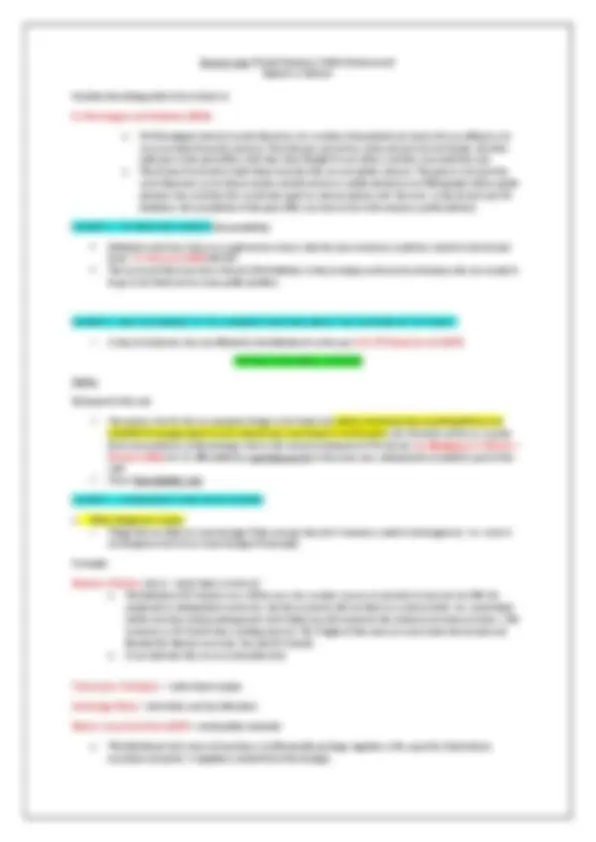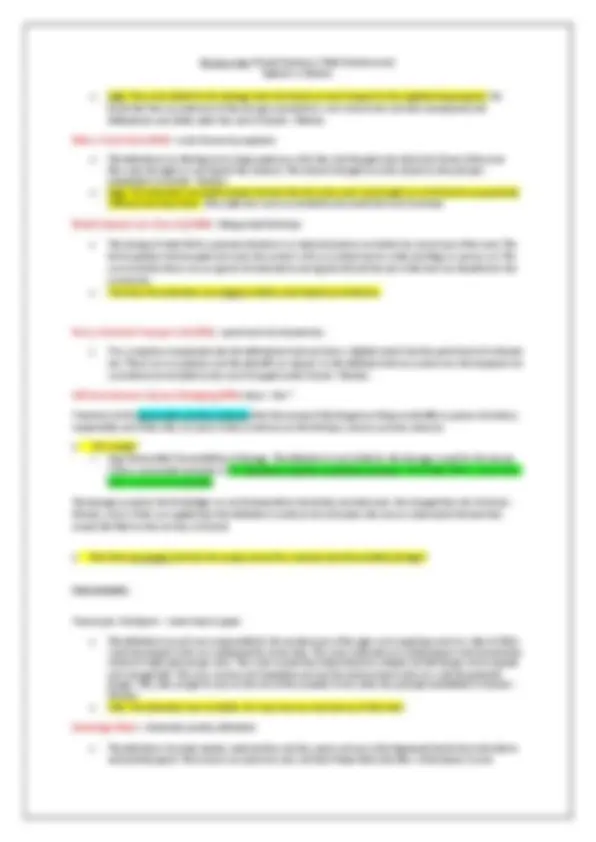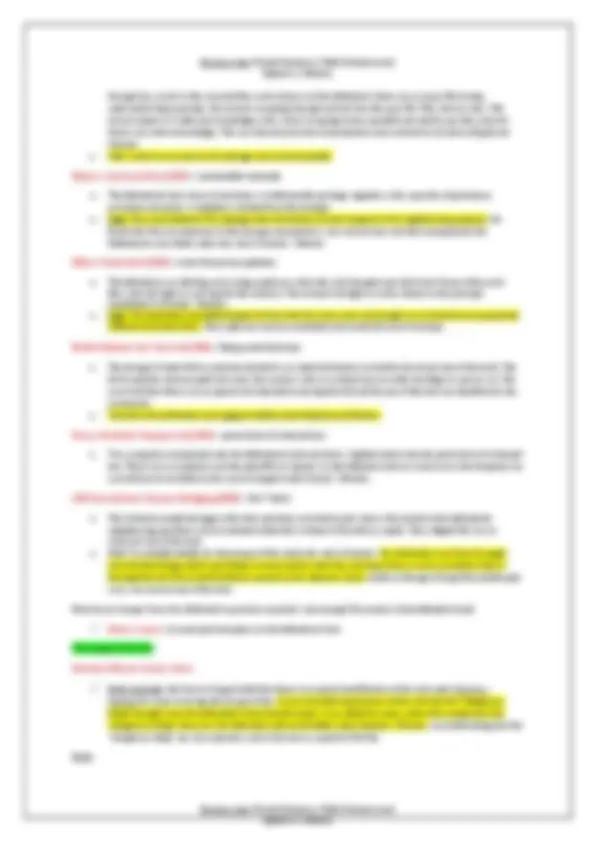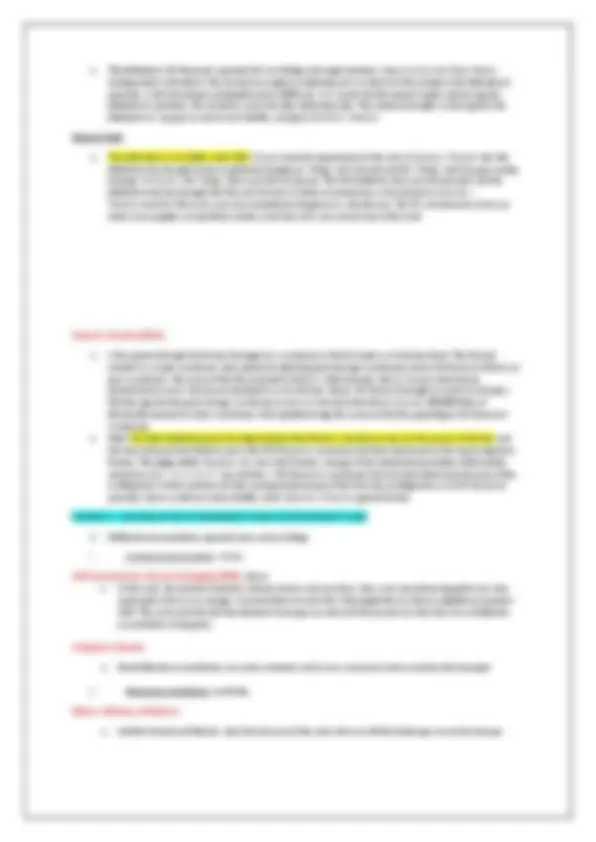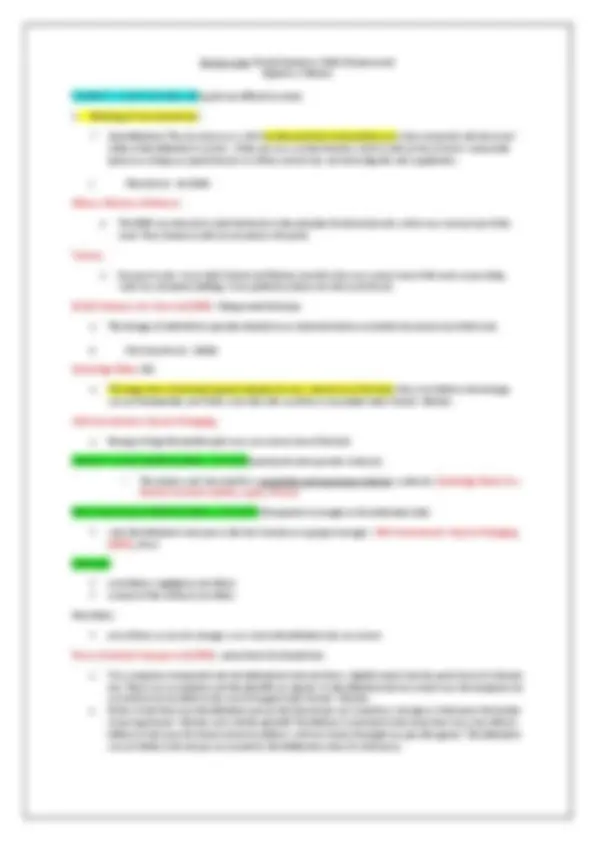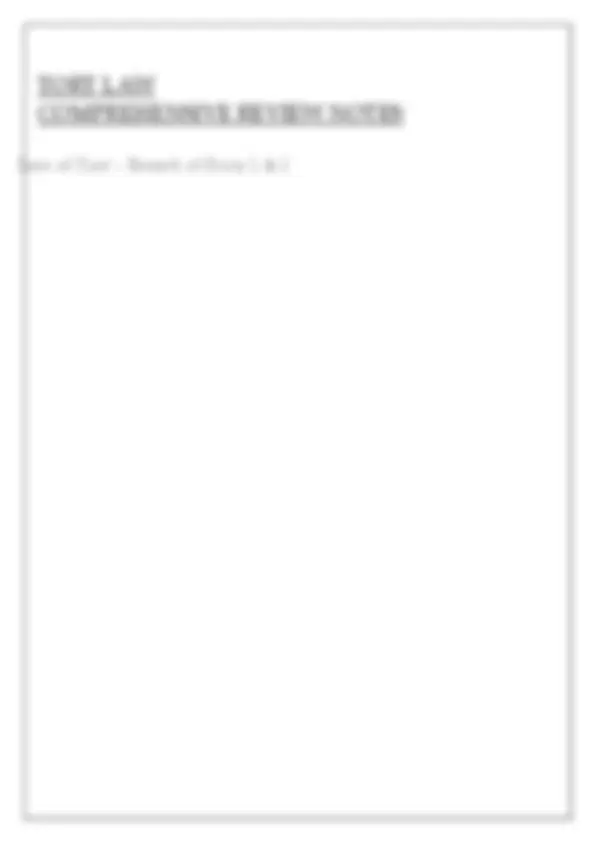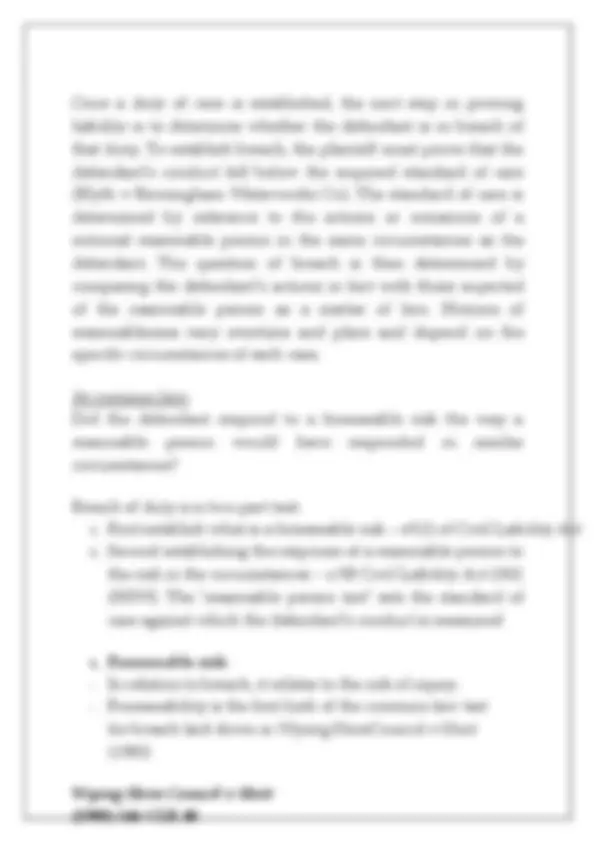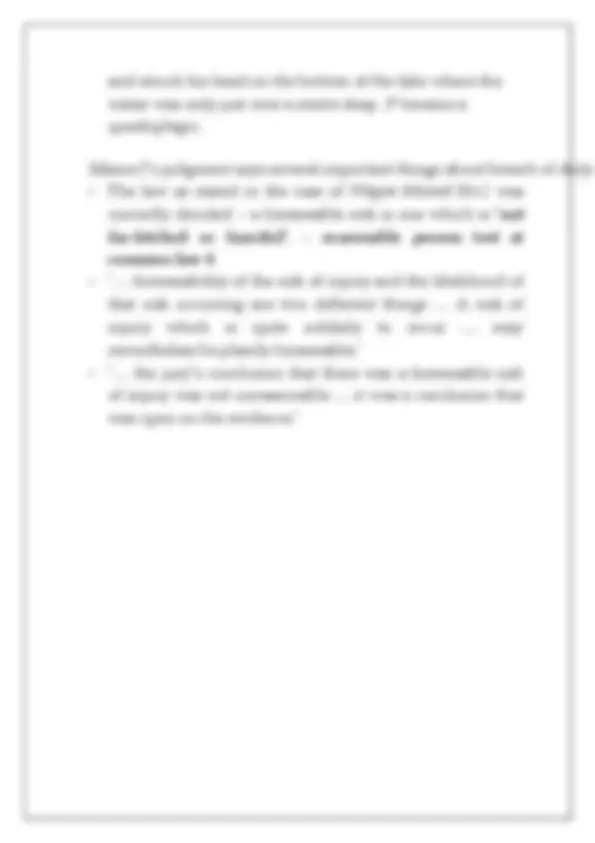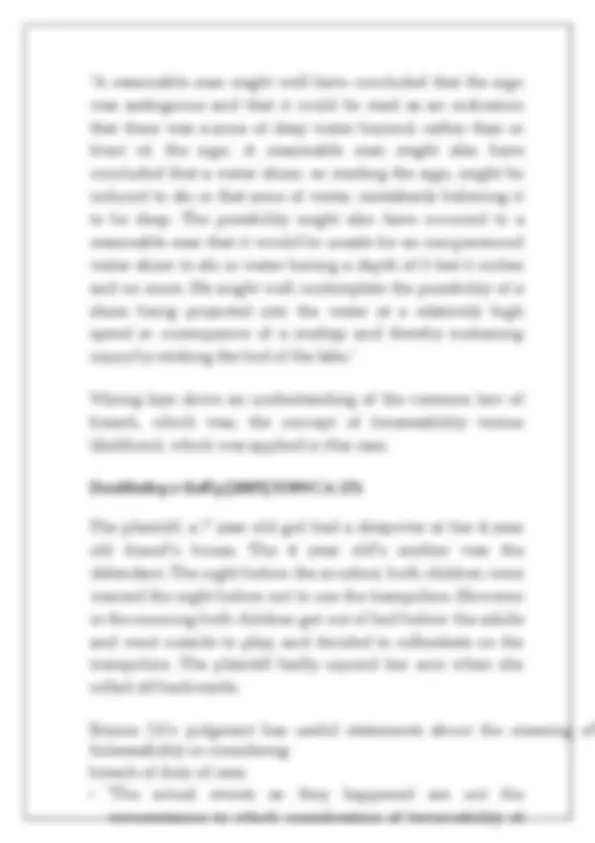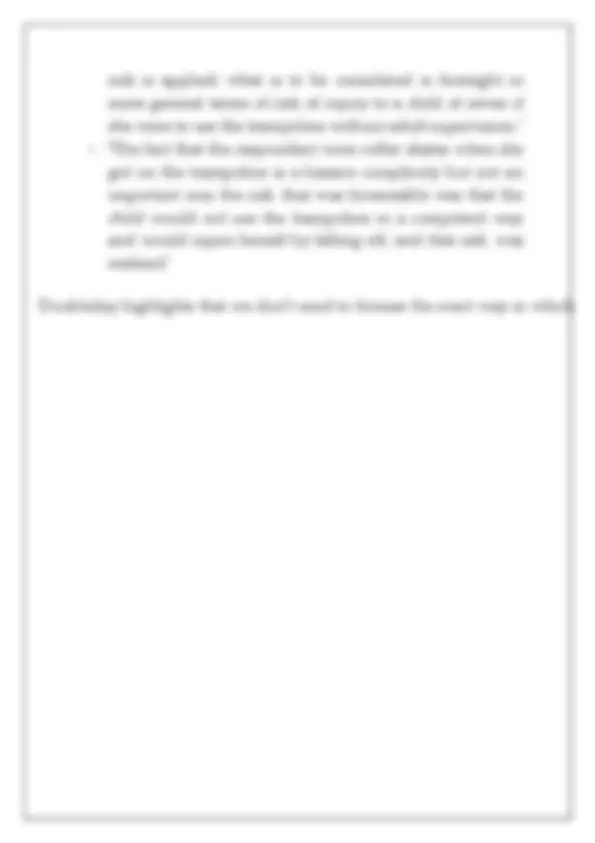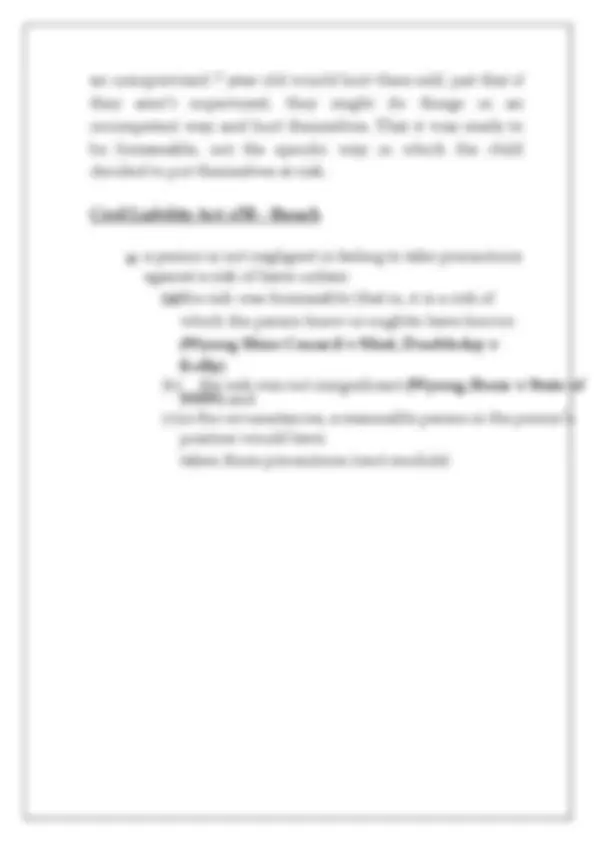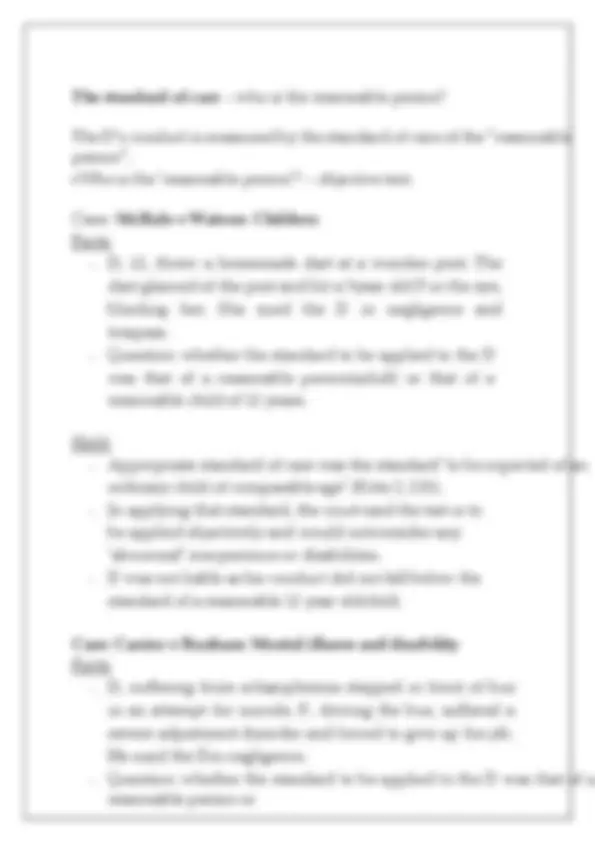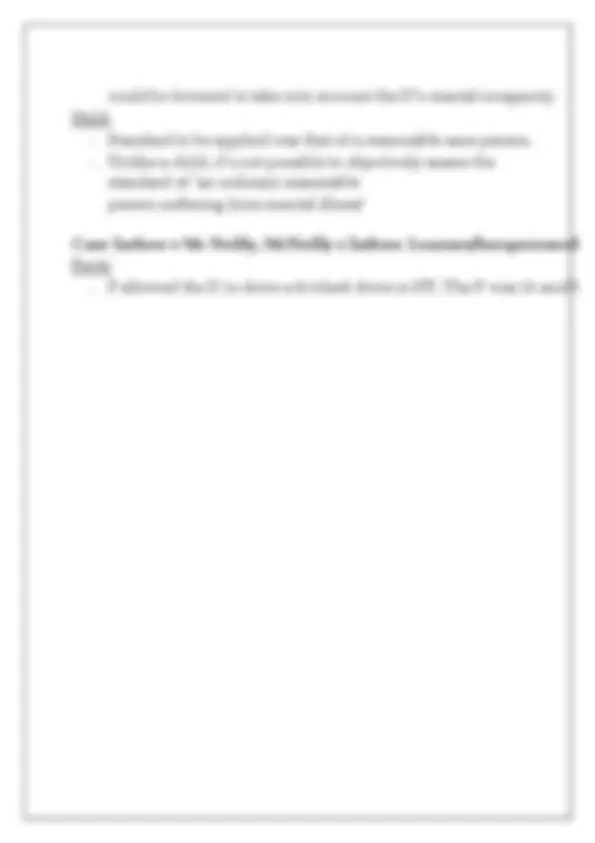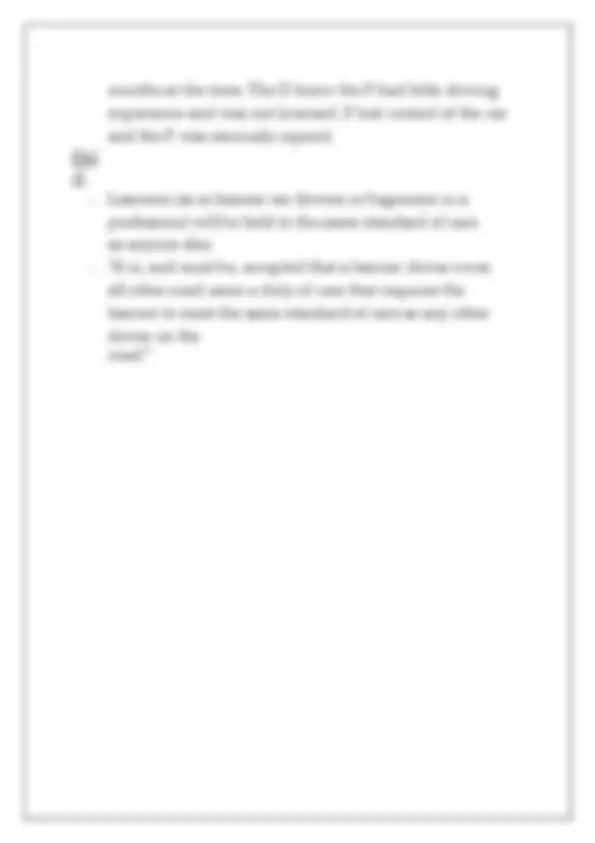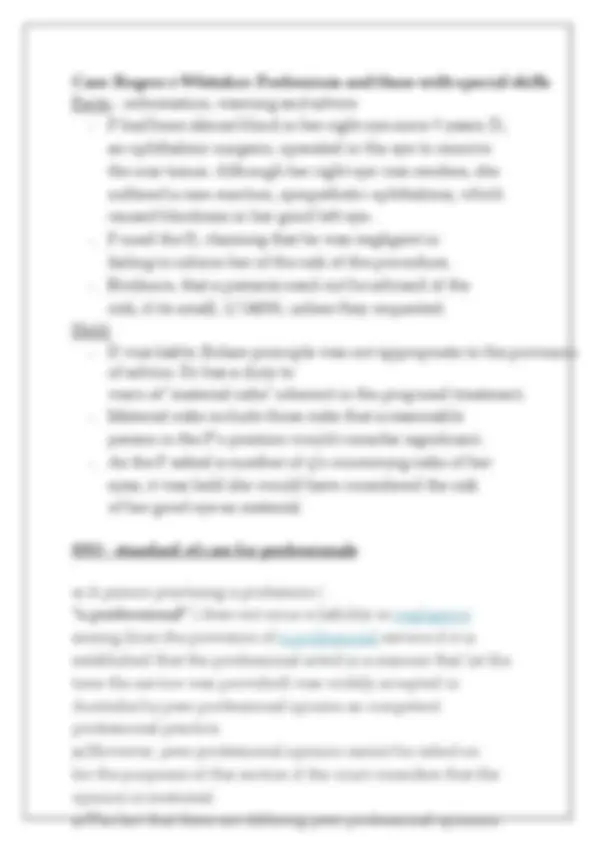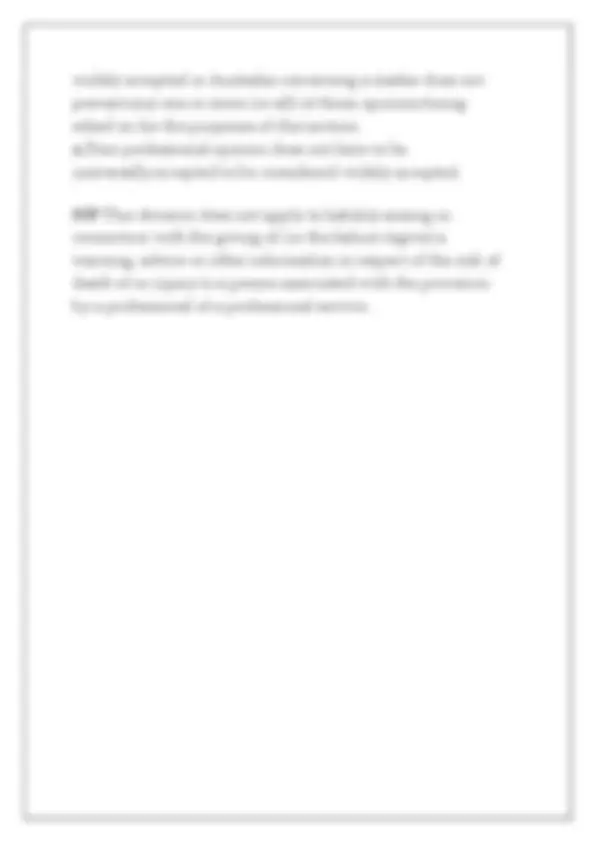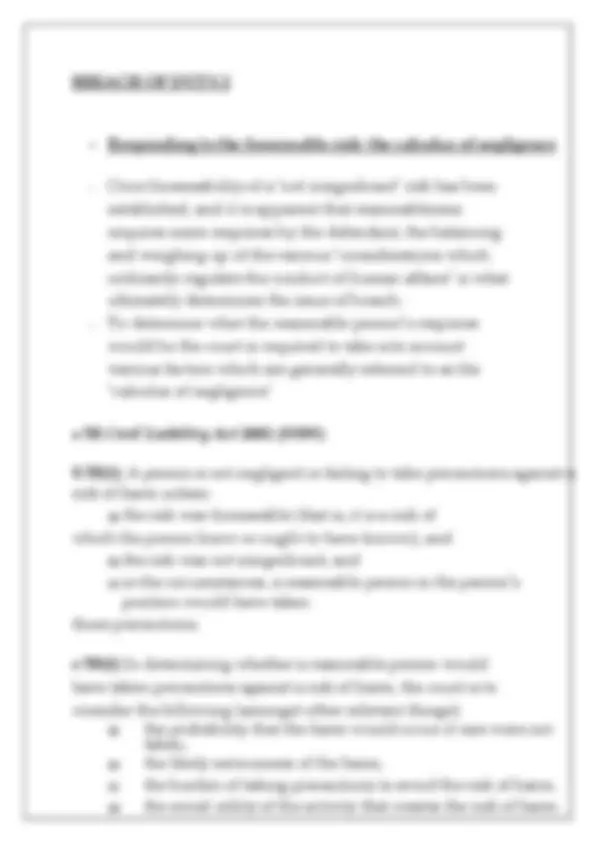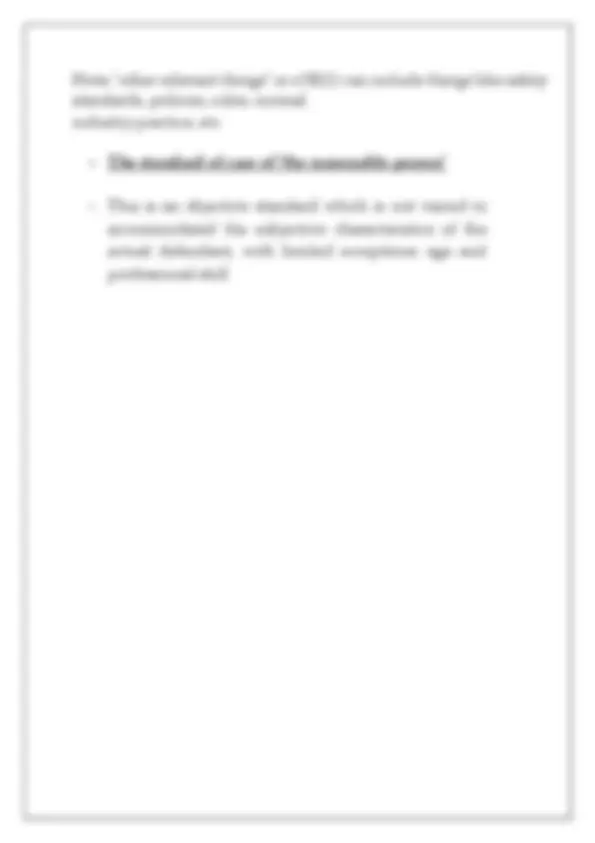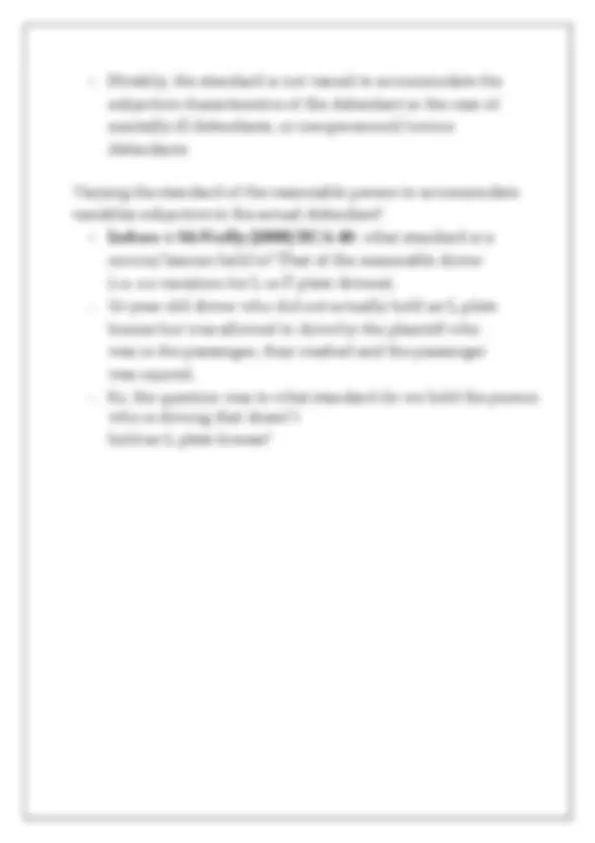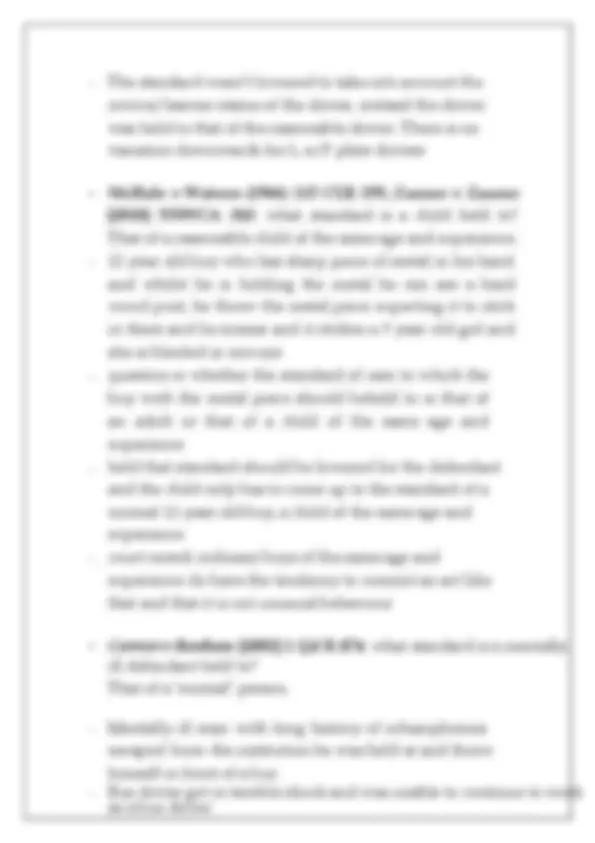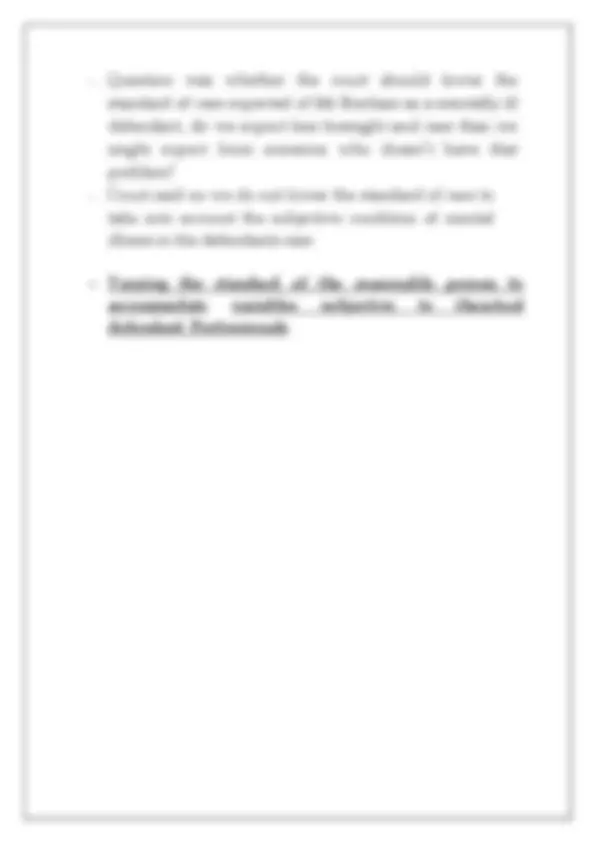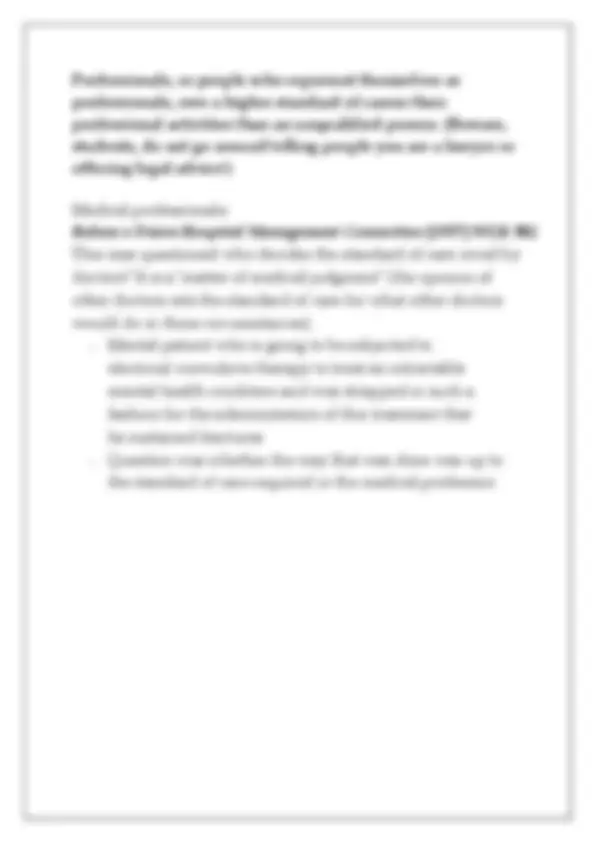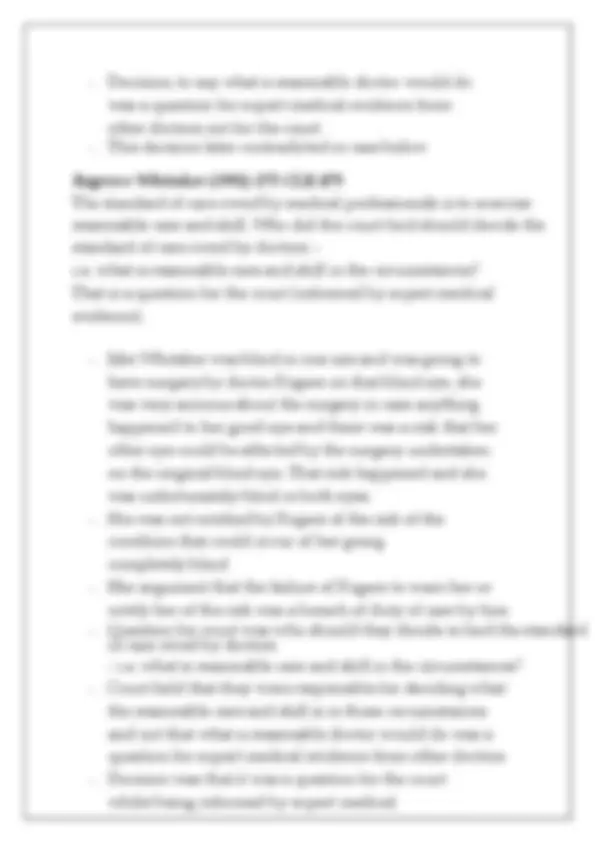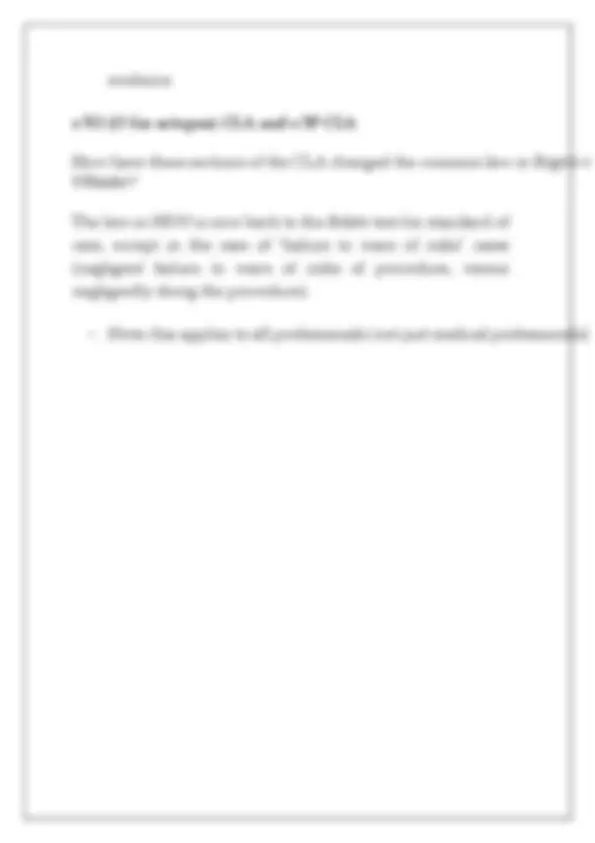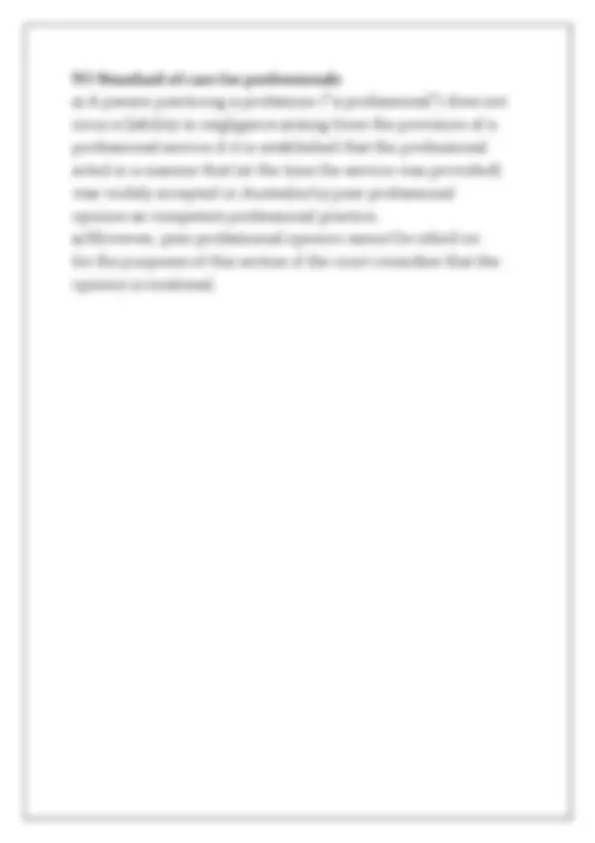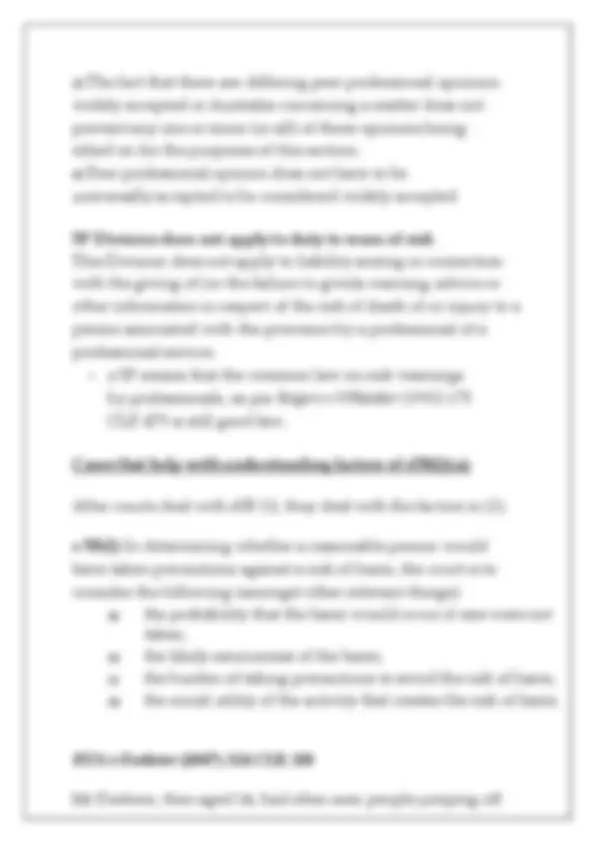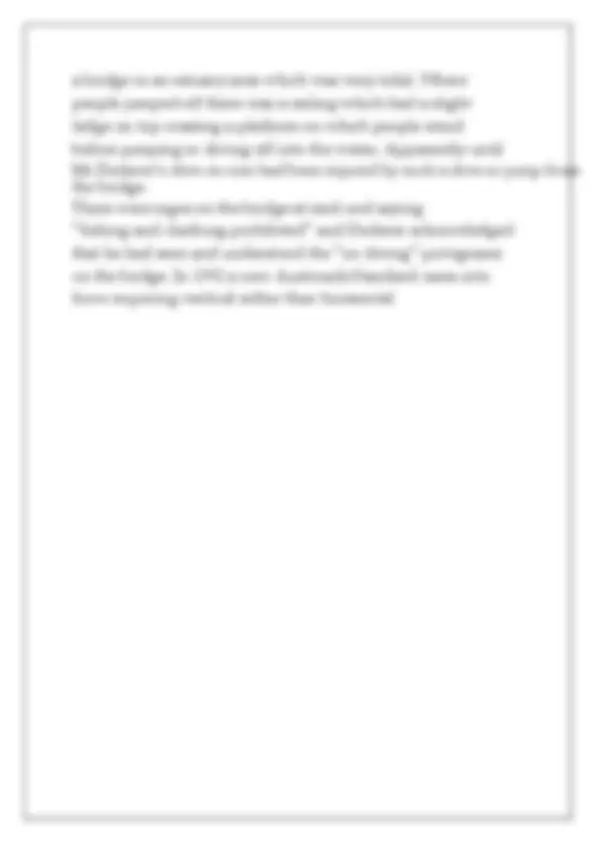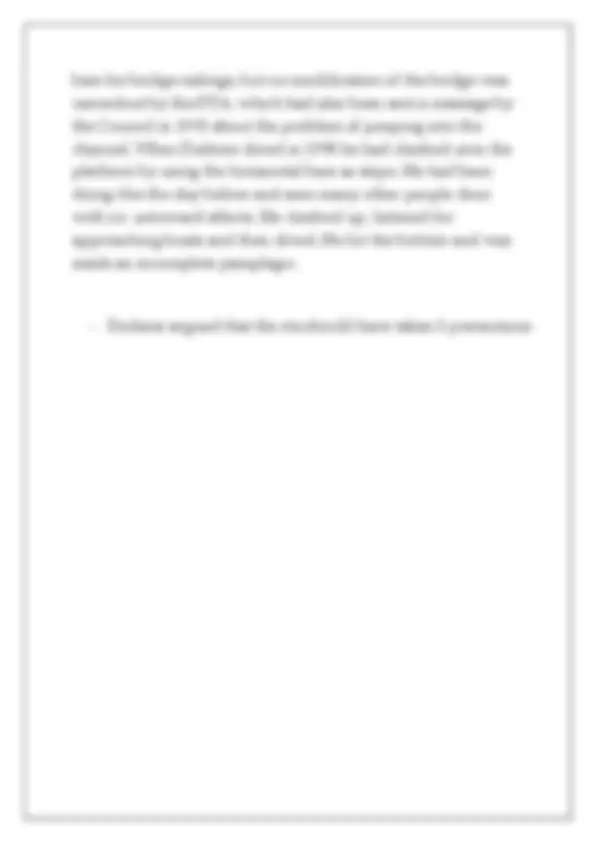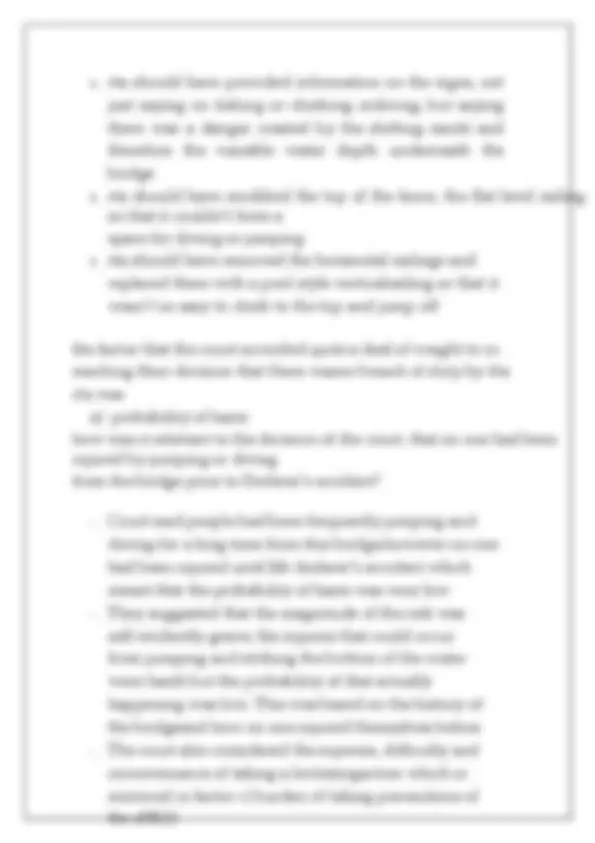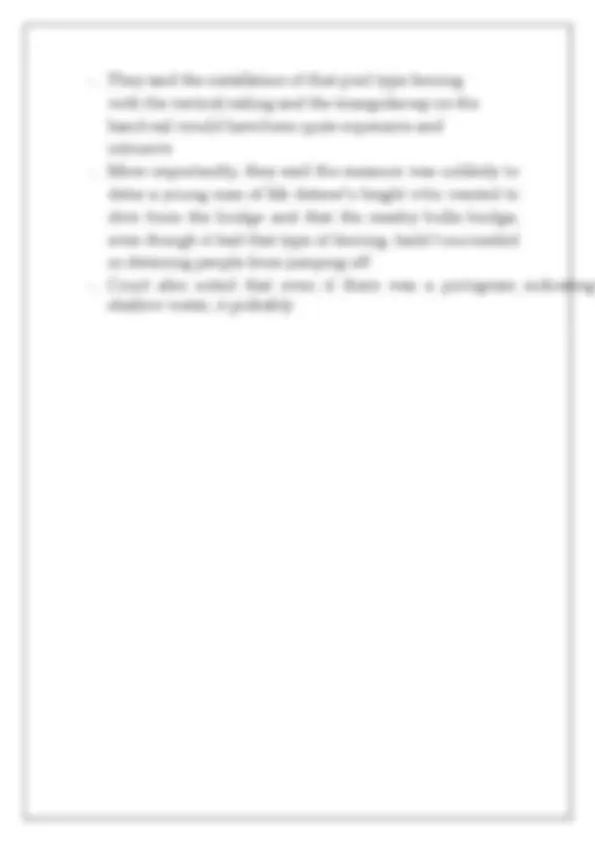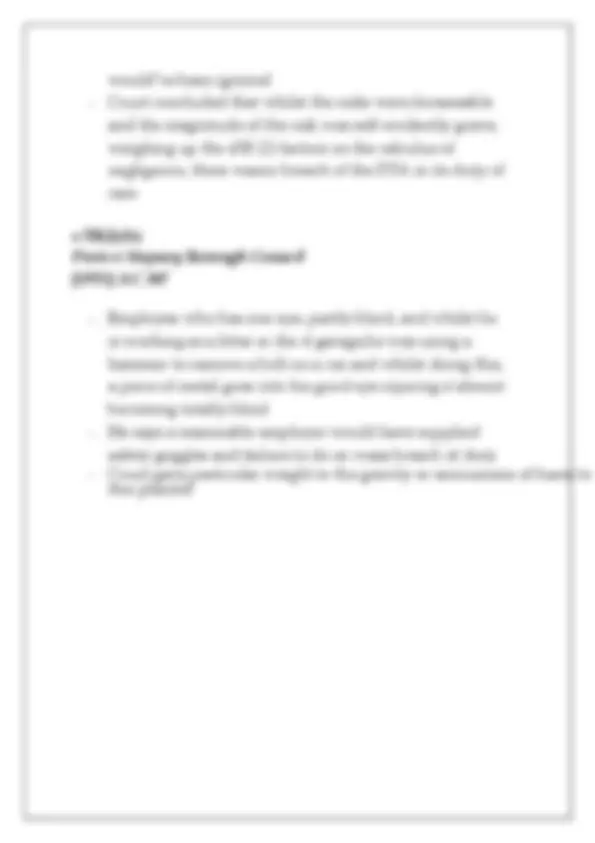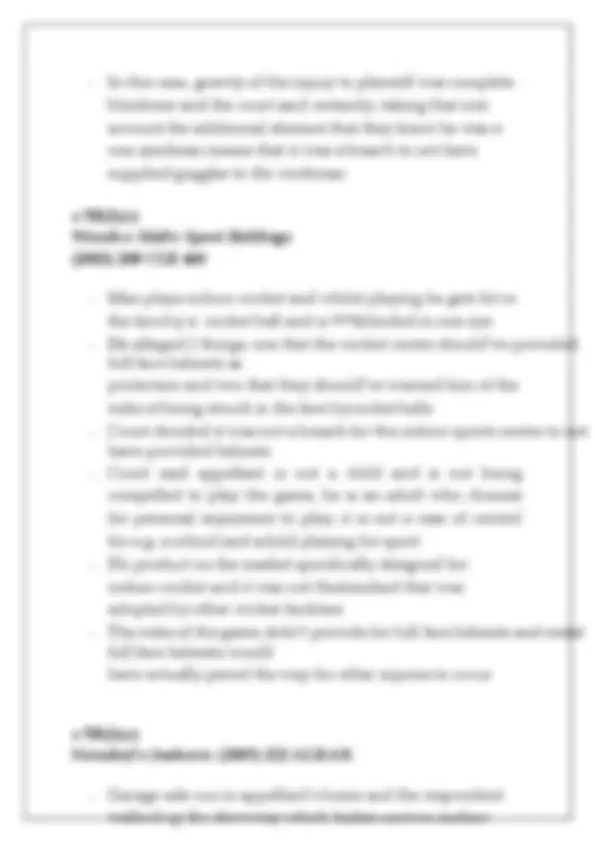Download Tort Law: Comprehensive Review Notes and more Study notes Law in PDF only on Docsity!
TORT LAW
COMPREHENSIVE REVIEW NOTES
ACTIONABLE DAMAGE
PHYSICAL INJURY
Only actual physical injury / illness is recoverable in negligence. An increased risk of suffering an illness in the future is not itself actionable damage; C will not have a claim unless and until the risk materialises and C contracts the illness.
- Rothwell v Chemical Insulating Co [2007]: Cs sued their employer who had negligently exposed them to asbestos. Cs had developed pleural plaques, which were evidence they were at risk of developing asbestos related diseases. HL: Cs could not recover for either the pleural plaques (no evidence they were harmful on their own) nor the risk of developing a disease in the future. Lord Rodger: “ Neither the risk of developing those other diseases caused by asbestos fibres in the lungs nor anxiety about the possibility of that risk materialising could amount to damage for the purposes of creating a cause of action in tort. ” PSYCHIATRIC INJURY Psychiatric injury consequential on physical injury : C can claim for it without recourse to the below rules (confirmed in Alcock ) — no need to show a recognised physical illness, can claim for ‘pain and suffering’. Psychiatric injury consequential on property damage: C can claim if she can show causation and reasonable foreseeability: Attia v British Gas [1987]: D (heating engineers) negligently installed a central heating system which burned down C’s house. CA : accepted
C’s claim for nervous shock. White v CC South Yorks [1999] Lord Steyn articulated the main reasons for limits on recovery for freestanding mental injury :
- The nature of the damage: It can be difficult to distinguish ‘acute grief’ from genuine ‘psychiatric illness’. Drawing the line would require expert evidence, adding to the time/cost of litigation if it was actionable in the same way as physical injury. o Criticism: expense of litigation isn’t a valid reason to deny recovery to deserving Cs. It will often be clear that C is suffering from a recognised illness (e.g. PTSD) particularly with modern improvements in the treatment / diagnosis of the mentally ill.
- Allowing recovery can be “an unconscious disincentive to rehabilitation.” o Criticism: this doesn’t seem to be based on evidence.
- Allowing recovery would ‘open floodgates’. Two limbs:
Rescuers are only ‘primary’ victims where they are within the range of foreseeable physical injury / objectively exposed themselves to danger.
- White v CC South Yorks [1999]: Could police officers who attended the Hillsborough Stadium disaster claim against their employer for psychiatric damage? HL: they could only claim under the normal Alcock / Page rule: i.e. if the employer had breached his duty of care in protecting employees from physical harm. Here that was not satisfied. o Hoffmann: rescuers should not be ““given special treatment as primary victims when they were not within the range of foreseeable physical injury and their psychiatric injury was caused by witnessing or participating in the aftermath.” This is because: ▪ Definitional problems: if rescuers fell into their own category, it would present serious problems in terms of defining ‘rescuer’. ▪ Distributive justice: “unacceptable to the ordinary person” for rescuers to be able to recover for psychiatric injury automatically because it would be “unfair between one class of Cs and another.” I.e. the relatives of Hillsborough families were subject to restrictive rules in Alcock, so police had to be treated the same way. o Steyn: “ to contain the concept of rescuer in reasonable bounds for the purposes of… compensation for pure psychiatric harm, C must at least satisfy the threshold
requirement that he objectively exposed himself to danger or reasonably believed that he was doing so.”
- McFarlane v EE Caledonia [1994] C was on a support vessel near an oil rig which exploded. C witnessed the destruction of the rig and the death of 164 people, although the closest he came was 100m. Stuart-Smith LJ: C could claim as a primary victim. This category extends to “C who is not actually in danger, but because of the sudden and unexpected nature of the event … reasonably thinks that he is.” However, the key test is whether D ought reasonably to have foreseen that such a person in the position of C might be killed / physically injured. Page applied narrowly in Rothwell : Seems the psychiatric illness be caused directly from the exposure to a sudden risk of physical injury, not the later apprehension that harm may occur: - Rothwell [2007]: C sued for depression / psychiatric illness caused by his fear of developing an asbestos related disease since the pleural plaques meant he was at a higher risk. HL (Lord Hoffmann): Page did not apply to allow C to recover as a primary victim — his injury was caused by worry about what might occur: “it would be an unwarranted extension of the principle in Page v Smith to apply it to psychiatric illness caused by apprehension of the possibility of an unfavourable event which had not actually happened ”. o Criticism: not clear why C could not recover. In both Page and Rothwell it was foreseeable C would come to physical harm, but C instead suffered psychiatric illness. Seems in Page the psychiatric injury flowed from C being in a position of real physical danger at the time of breach, but in Rothwell, C’s psychiatric injury was caused by the later realisation he was at risk — he was never in ‘danger’ in the sense of fearing for his immediate safety (as in Page ). Involuntary participants in D’s harm to another? In Alcock Lord Oliver suggested C may be a primary victim where D’s conduct causes C to be an involuntary participant in an incident causing
died. He suffered a psychiatric illness as a result. CA: C was not entitled to damages as he was not a primary victim, he only reacted to what he had been told.
3. Secondary Victims A secondary victim is a person who suffers psychiatric injury as a result of witnessing / being informed about an accident, but who was not in the zone of danger. The rules were developed in: Alcock v CC South Yorks [1992]
- Facts: Cs were family members / friends of victims of the Hillsborough disaster who had seen live pictures of the incident on TV. Cs suffered shock and resulting psychiatric illness. Claimed against the local authority responsible for policing the disaster.
- HL: they could not recover for these illnesses as secondary victims. The requirements are: 1. Reasonable foreseeability: It must be reasonably foreseeable that a person of reasonable fortitude would suffer psychiatric injury as a result of D’s negligence: 2. Close ties of love and affection: this is tied up with concerns about foreseeability. o Rebuttable presumption where C is in a close familial relationship with V (parent/child; husband/wife; engaged couple). o Other relationships: (siblings, grandparents, friends): C must prove a close tie of love and affection exists. 3. C must be proximate in time and space: one C visited a relative killed in the crush eight hours after the incident — this was too long to satisfy the requirement of proximity 4. The psychiatric injury must flow from shock as a result of directly experiencing the incident / aftermath. Lord Ackner: Shock means “the sudden appreciation by sight or sound of a horrifying event which violently agitates the mind”. Seeing TV images is insufficient, at least where the footage does not show identifiable individuals (here just a crowd). This means injury sustained as a result of caring for an injured relative would not
qualify. McLoughlin v O’Brian [1983] C was sufficiently proximate when she saw her dead child / injured family in hospital after a car crash. She arrived after two hours, it having taken a while for the news to reach her. Thus C may be temporally and spatially removed at the time of the accident and still be sufficiently proximate. [note that treatment by commentators suggest this case is at the edge].
- Minority judgments : foreseeability alone should be the sole criterion of liability : if it was foreseeable that C would suffer psychiatric injury as a result of D’s negligence, then why shouldn’t C recover? Foreseeability is enough to contain floodgates risks, which do not materialise often in practice anyway. W v Essex : in addition to considering that the parents of molested children may be primary victims, Lord Slynn took a flexible approach to the proximity requirement — although the parents only learned of the molestation later on and did not have direct oral / visual perception of the incidents, this could be enough.
absolute defence to liability and these concerns did not eventuate. Floodgates concerns are speculative so should not alone justify denying liability to deserving victims of psychiatric injury. A requirement of foreseeability alone would avert much of the floodgates risk. o Despite arguing against a foreseeability-only approach, Wilberforce noted many of the arguments against it were capable of answer: “fraudulent claims can be contained by the courts, who, also, can cope with evidentiary difficulties. The scarcity of cases which have occurred in the past, and the modest sums recovered, give some indication that fears of a flood of litigation may be exaggerated - experience in other fields suggests that such fears usually are. If some increase does occur, that may only reveal the existence of a genuine social need: that legislation has been found necessary in Australia may indicate the same thing.”
- Teff floodgates concerns can be avoided by imposing two requirements in secondary victim cases: (i) recognised medical condition; (ii) reasonable foreseeability of psychiatric injury, evidenced by a close relationship between C and the injured person or by other means e.g. a particularly horrific incident. The other requirements are arbitrary and unnecessary.
- Criticisms of Page : o In White v CC South Yorks , Lord Goff (dissenting) stated Page “ constituted a remarkable departure from … generally accepted principles .” In particular, it “ dethroned foreseeability of psychiatric injury from its central position as the unifying feature of this branch of the law ” by making a distinction between primary and secondary victims. Only for secondary victims was it still necessary for the claimant to establish the foreseeability of psychiatric injury; the primary victim had only to show the foreseeability of injury, whether physical or psychiatric. ▪ Goff’s Alternative: Goff suggests instead that the approach taken in the Wagon Mound (No. 1) should have been followed — here, fire was distinguished from other types of damage to property for the purpose of deciding what D could reasonably have foreseen — “ on exactly the same grounds, a particular type of personal injury, viz. psychiatric injury, may, for the like purpose, properly be differentiated from other types of personal injury .” Further this approach is consistent with “scientific advances revealing that psychiatric illnesses may have a physical base or that psychiatric injury should be regarded as another form of personal injury .” Arguments in favour of the current law:
- Wilberforce in McLoughlin : Argued foreseeability alone should not be enough (although note he thought some of these arguments could be answered — see above). o Would lead to a proliferation of claims / fraudulent claims in road traffic / factory accidents. o Would be unfair to Ds to impose damages out of all proportion to negligent conduct. In so far as Ds are insured, a large burden will be placed on insurers, and ultimately onto persons injured. o To extend liability would lengthen litigation / lead to evidentiary difficulties. o An extension of the scope of liability ought only to be made
▪ Young v Charles Church [1997]: C saw his colleague die when he touched an overhead electric cable. C claimed against his employer for psychiatric injury. CA: D was liable because C was a primary victim within the area of physical danger (even though C’s injury was caused by witnessing his colleague’s death, not his own proximity to harm).
- Argument for 2 : Fear of proliferation of claims stemming from a single event is reduced if Cs are limited to those who are in physical danger.
- How wide is the zone of danger? Trindale : e.g. if a crashing plane went low over a city before impacting a building, could all those who thought the plane might come down on them be regarded as primary victims? Unless the courts narrowly define it there could be a very large number of claims in such cases.
- Categories of primary victims closed? In W v Essex , Lord Slynn commented “ the categorisation of those claiming to be included as primary or secondary victims is not as I read the cases finally closed. It is a concept still to be developed in different factual situations .” L+O: such statements risk increasing confusion. Further, if the category of primary victims is enlarged, this may well undermine the proximity requirements currently applied in secondary-victim cases.
- Would the broad Alcock classification be better? Here the test was those who ‘participate’ in the negligent event — this would catch rescuers etc. The advantage is that “the main objection to the narrow classification is overcome: the broad classification supports the idea that recovery for psychiatric illness exists as a distinct harm, as worthy of support as physical injury… it has a validity of its own independent of any physical injury or risk of physical injury.” o Difficulty with this is that it provides little guidance as to where to draw the line between primary and secondary victims. What amounts to ‘direct involvement’ and what is the ‘event’?
- Law Commission : “we consider the distinction to be more of a hindrance than a help.” They note that the courts have struggled to draw the line with precision — i.e. in Hegarty v EE Caledonia a rescuer had to show he feared for his personal safety, but this was not the case in Frost [1997] — the courts should “abandon attaching practical significance to whether C may be described as a primary or secondary victim.” [ EP: although they do recommend drawing a line between cases where the person ‘killed/injured/imperilled’ is
not C, and where C himself is killed/injured/imperilled’ — in these cases ‘special restrictions’ over and above a foreseeability test would apply]. Law Commission recommendations on secondary victims:
- Key recommendations: C’s proximity to the scene of the “ accident ”, and the manner by which he or she learns of it, should not be used as criteria to restrict the claim. Further, recommend that the requirement that psychiatric illness be induced by a shock should be abandoned. Law pertaining to primary victims should stay the same.
- Reject a straightforward reasonable foreseeability test: A simple foreseeability test could result in a significant and unacceptable increase in the number of claims. This in turn might lead the courts to make use of policy considerations, concealed beneath the foreseeability test, in an attempt to restrict the number of successful claims. Such confusion could only result in
remoteness of damage. The distinction between pure and consequential economic loss can be seen in Spartan Steel [1973]: D damaged an electric line powering C’s factory. The factory lost power and C claimed for both the loss of the product lost in the furnace (consequential economic loss) and future profits from the use of the furnace (pure economic loss). CA: only the former was recoverable. There are, however, four categories in which PEL is recoverable: (i) negligent misstatements and negligence in professional services; (ii) the acquisition of defective products / premises; (iii) damage to property of a third party which causes economic loss to C; (iv) wrongful life conception cases. Reasons why pure economic loss is generally not recoverable :
- Economic loss is the domain of the law of contract and the intentional economic torts.
- Stapleton : restrictions are based on policy concerns, particularly the floodgates argument: o Indeterminate number of potential claimants o Indeterminate extent of liability to a particular claimant.
The floodgates arguments are based on the ripple effect of economic loss: loss of profits to one business may cause financial loss to its suppliers, customers and other organisations or businesses in which it would have invested.
- The rights view (Stevens ): tort law is about protecting rights; we don’t have a right against the whole world not to have economic loss brought upon us. Such a right can only arise against an individual person based on an assumption of responsibility. A general right that others do not cause us economic loss would make business impossible.
- Witting : our interest in wealth is less important than our interest in our health or property because our health and property are part of our identity but wealth is not.
- Imposing liability for PEL is a much greater burden and limitation on defendants’ freedom because there is a much greater range of things which will cause PEL compared to things which will cause personal injury or damage to property.
- Atiyah : loss spreading: numerous small economic losses suffered by victims of D’s negligence is better/more efficient than one large loss to D. Negligent Misstatements and Professional Services Recovery under this head is useful where D gratuitously makes a negligent misstatement which C relies upon in entering a contract with X.
- If D’s misrepresentation induces C to enter a contract with D, C can sue D in contract under the Misrepresentation Act 1967.
- If D supplied C with incorrect information under a contract with C, then C can sue D in contract. Liability for negligent misstatement was first recognised in Hedley Byrne :
- Hedley Byrne [1964] : D bank provided C with a credit reference regarding X. C relied on this reference to enter an advertising services contract with X. X went bankrupt. HL: in principle C could sue D in negligence, although here C could not because of a
- Smith v Bush [1990]: C applied for a mortgage. The bank instructed D to survey the house. D negligently reported no essential repairs were needed. C relied on this report and purchased the house / entered the mortgage agreement. A chimney collapsed. C sued D. HL: D owned C a duty of care in respect to C’s PEL caused by the chimney collapse (PEL because D’s negligence did not cause the chimney to collapse). o Touchstone of liability is reasonable reliance: decision was heavily based on the fact that it was reasonably foreseeable to D that C would rely on his report. Lord Griffiths criticised the ‘voluntary assumption of responsibility’ test in Hedley Byrne for being ‘an empty phrase’ and not a real test — it actually means “ the circumstances in which the law will deem the maker of the statement to have assumed responsibility ”. The focus on reasonable reliance in Smith leaves the potential for a very broad test of recovery for PEL. Stapleton criticises this approach on the grounds that reliance is so common in our society that it’s an unhelpful limit on liability. A narrower approach was adopted in Caparo :
- Caparo v Dickman [1990]: C made a bid to take over a company on the basis of false information in the company’s accounts. C sued D, the auditor who prepared the accounts for PEL. HL: C’s claim failed — C and D were not in the requisite “special relationship”. This relationship is required to constitute the ‘proximity’ limb of the tripartite Caparo test. o Test for the required proximate relationship: (i) The purpose of D’s statement: (ii) the identity of C, “either as an individual or as a member of an identifiable class” to whom D’s information will be communicated; (iii) the fact that D’s advice will be communicated to C; (iv) the fact C is very likely to rely on D’s advice in deciding whether to enter into the transaction. ▪ The second and third requirements of the “ special relationship ” will be particularly important in three party cases, but will always be satisfied in two party cases. o This case: C failed on the second element — C was a member of the public at large, D had no knowledge of C as a person to
whom his advice would be communicated. Caparo pulled back significantly from Smith v Bush in that foreseeable reasonable reliance alone will not give rise to a duty of care for PEL, but only where there is the necessary ‘special relationship’. These requirements will be easier to satisfy in a two party cases than a three party case.
- Reconciling Smith and Caparo : L+O suggest it comes down to the pre-eminence role given by the HL to the purpose of the statement — in Caparo the auditors were employed so the company could comply with its statutory duty to provide shareholders with performance information, not to give potential investors information with which to make decisions; in Smith the statement pertained to the integrity of a specific building in relation to a specific transaction. This distinction may not be entirely convincing, since in Smith the primary purpose of the survey was to allow the building society to decide whether to make a loan. In effect the court deemed the survey to have an additional purpose — i.e. to allow a purchaser to decide whether to purchase the property. o In reality policy factors meant that a broad test for liability and recovery was justified in the circumstances of Smith v Bush but not in the circumstances of Caparo.

